Author: James Williams
Attaching the Facings
Let’s prepare the facing now in order to install it into the waistcoat. Begin by basting the two sections of the facing together at the bottom, right sides together. It’s easy to lose track of which way is which with the smaller bottom section, so compare it to your pattern to make sure it’s going the correct direction.
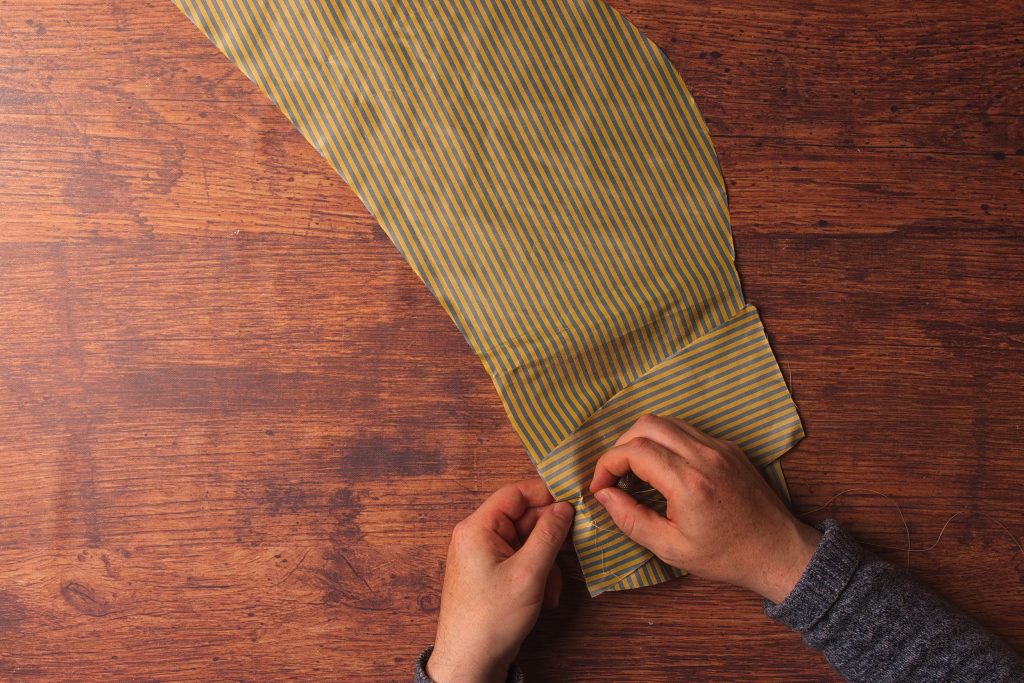
Sew using a 3/8″ seam allowance.
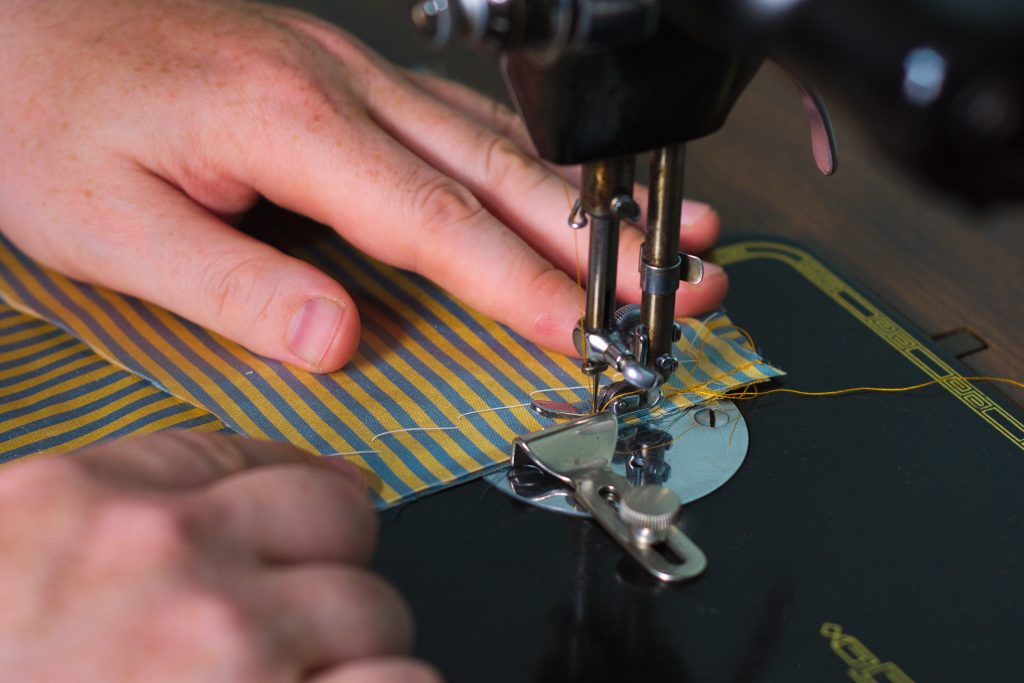

Press the seam open, keeping the seam allowances toward the back.
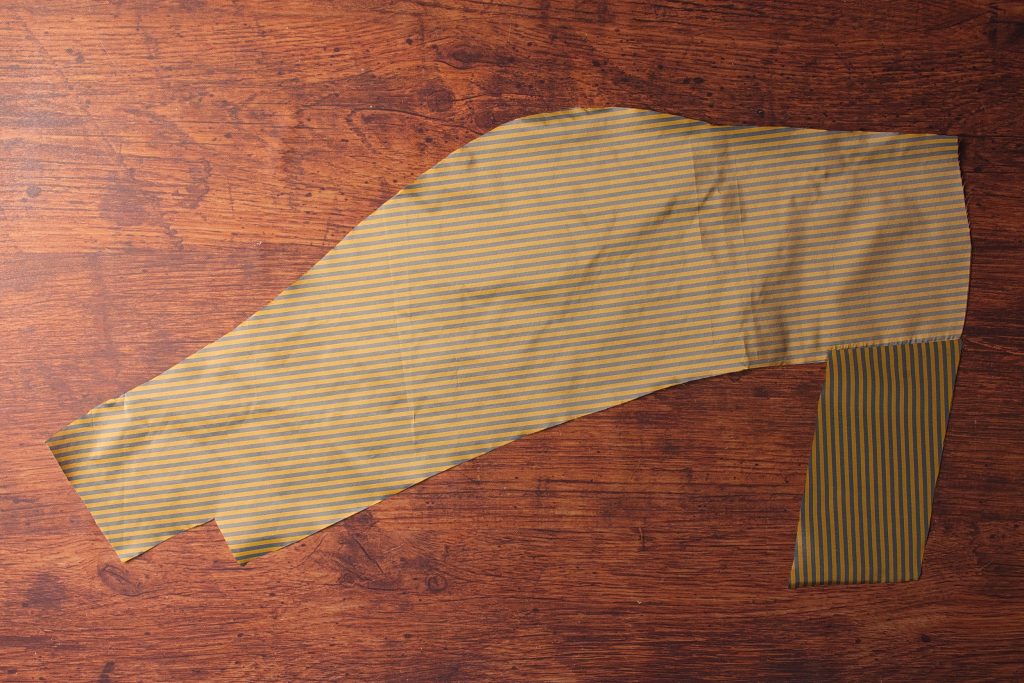
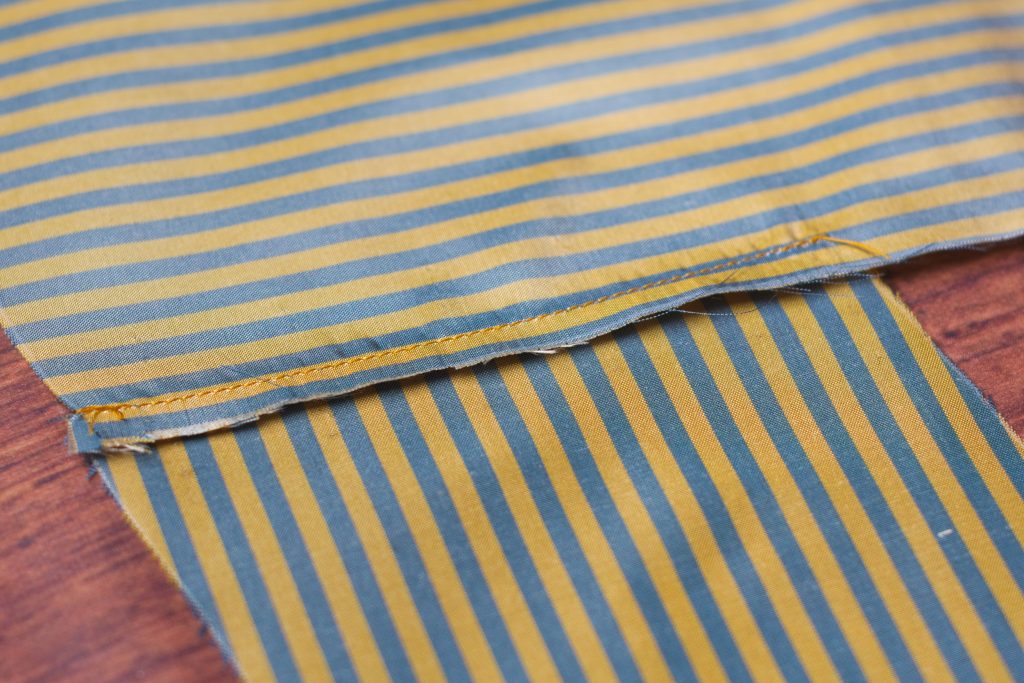
Now place the facing assembly on top of the forepart, right sides together.
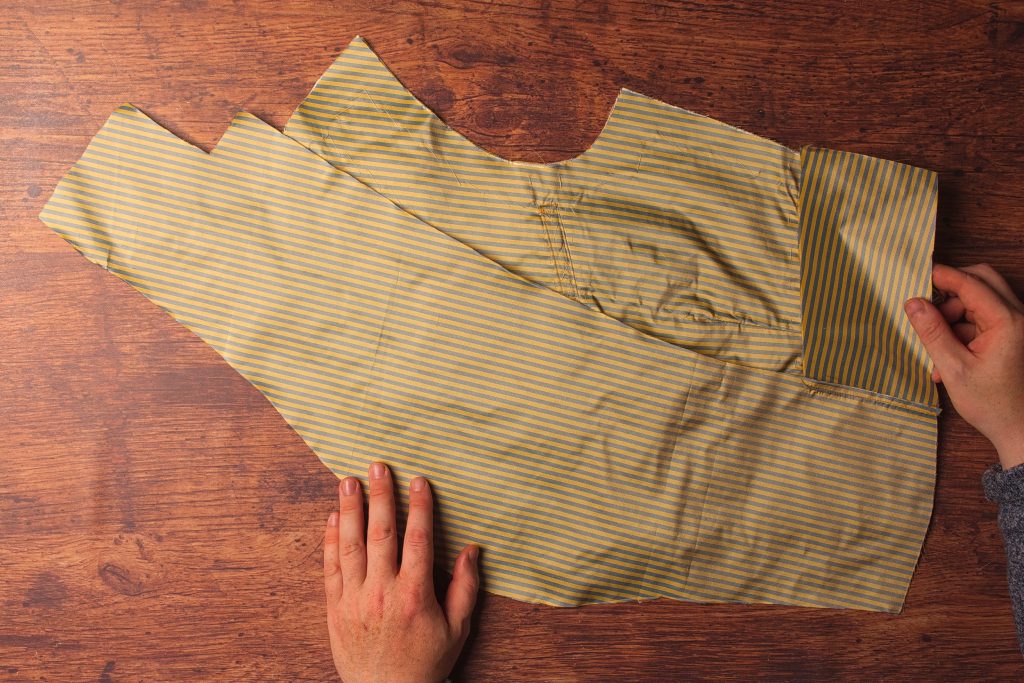
You should have cut the facing a little over-sized, so allow the facing to fall naturally over the shaped forepart.

Begin basting the facing to the forepart about one inch from the forepart edge.

At the bottom of the roll line, try to work in a little excess fabric into the facing. This will give the extra length necessary to curve around the folded collar. Secure with a couple of extra basting stitches as necessary.
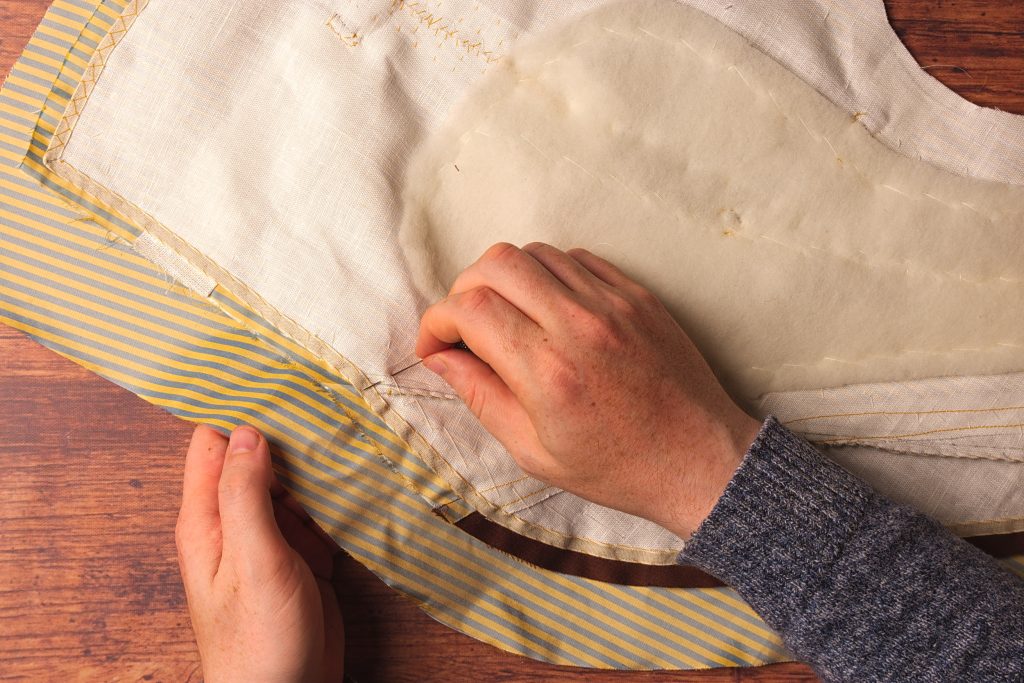
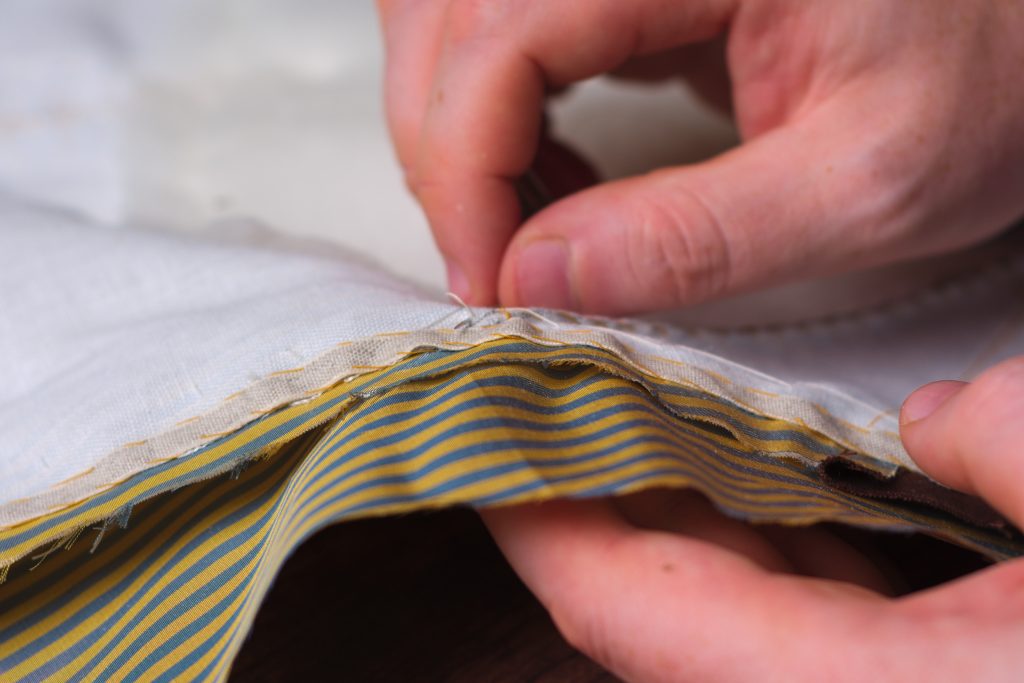
Continue basting across the bottom of the forepart.
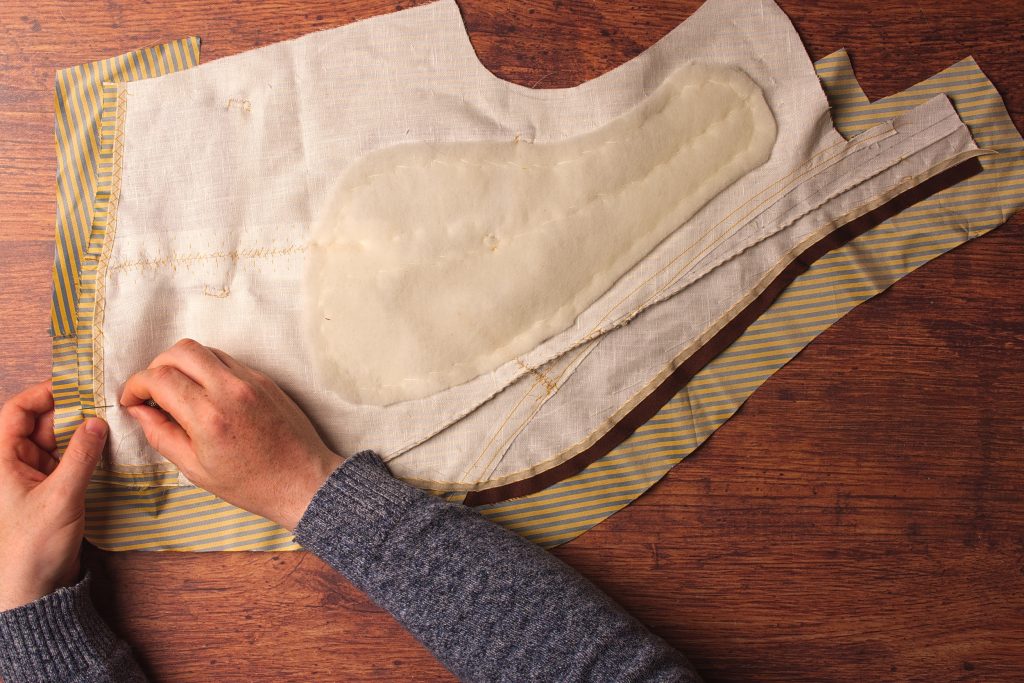
Here’s the forepart so far after basting in the facings.
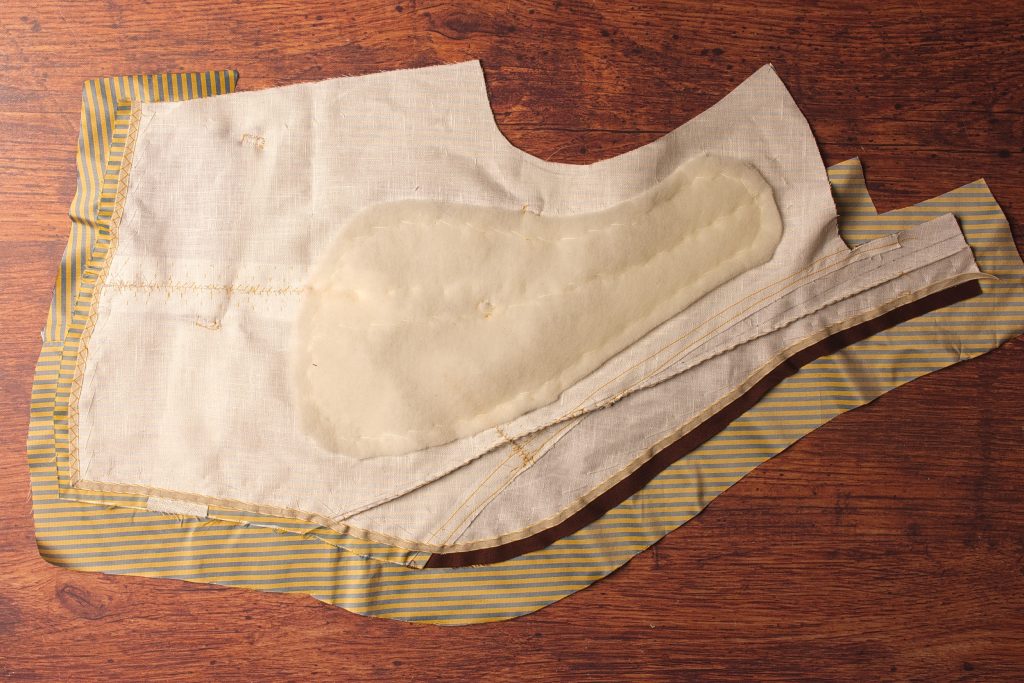
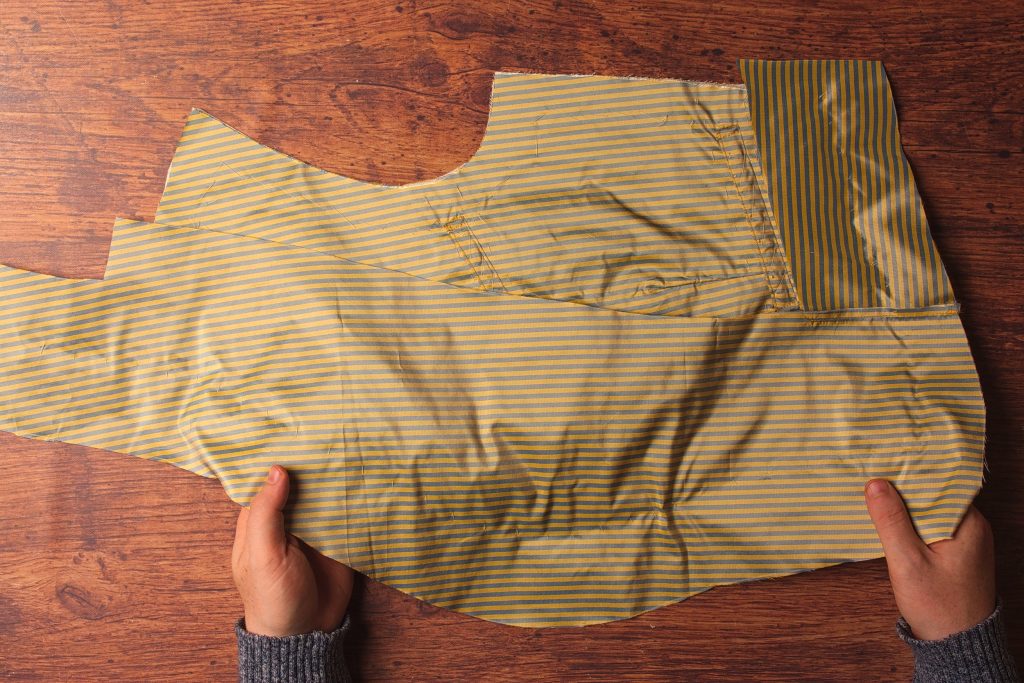
Turning to the wrong side, trim the excess from the facing along the front and bottom edges. Don’t trim the top or back of the collar or the shoulder area yet, however.
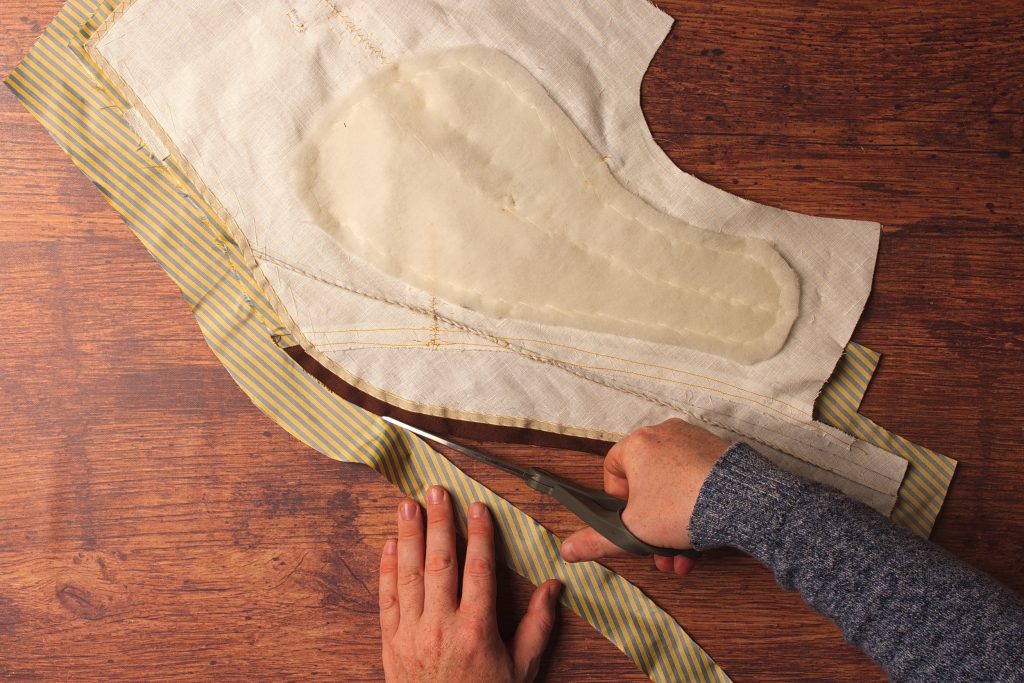
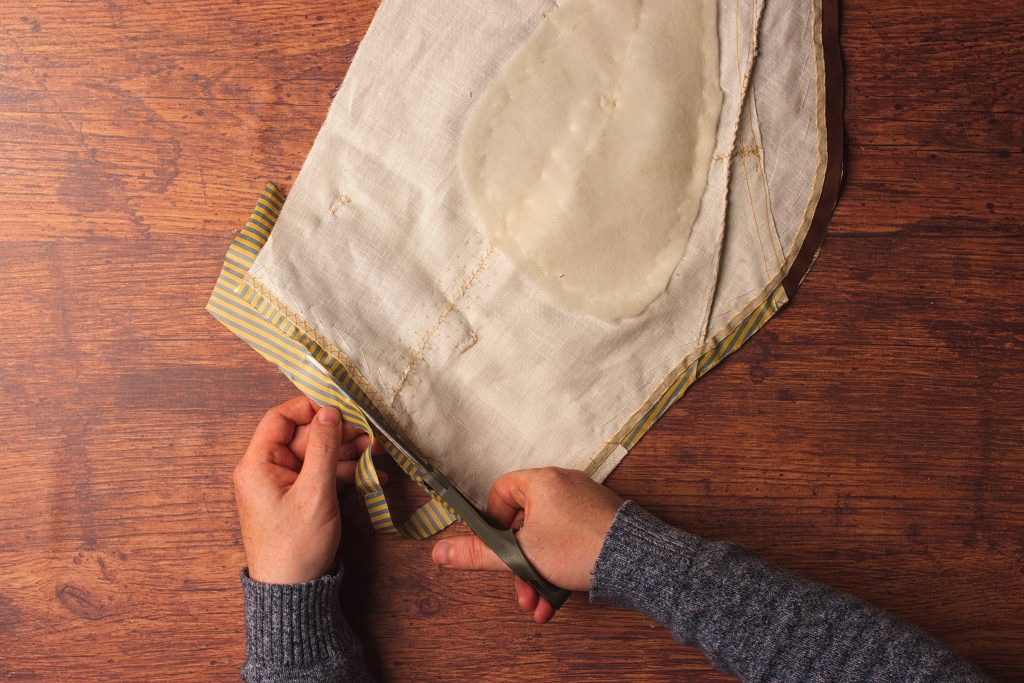
Here’s what you should have after trimming.
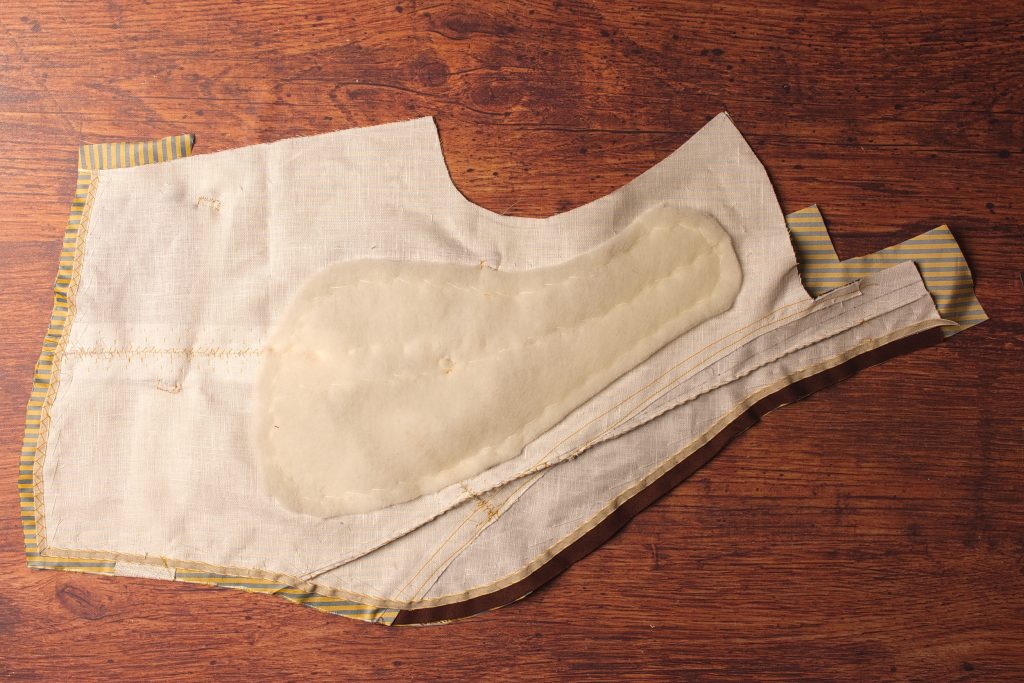
Starting at the top of the collar (or the waist depending on which side), sew the facings to the forepart using a 3/8″ seam allowance.
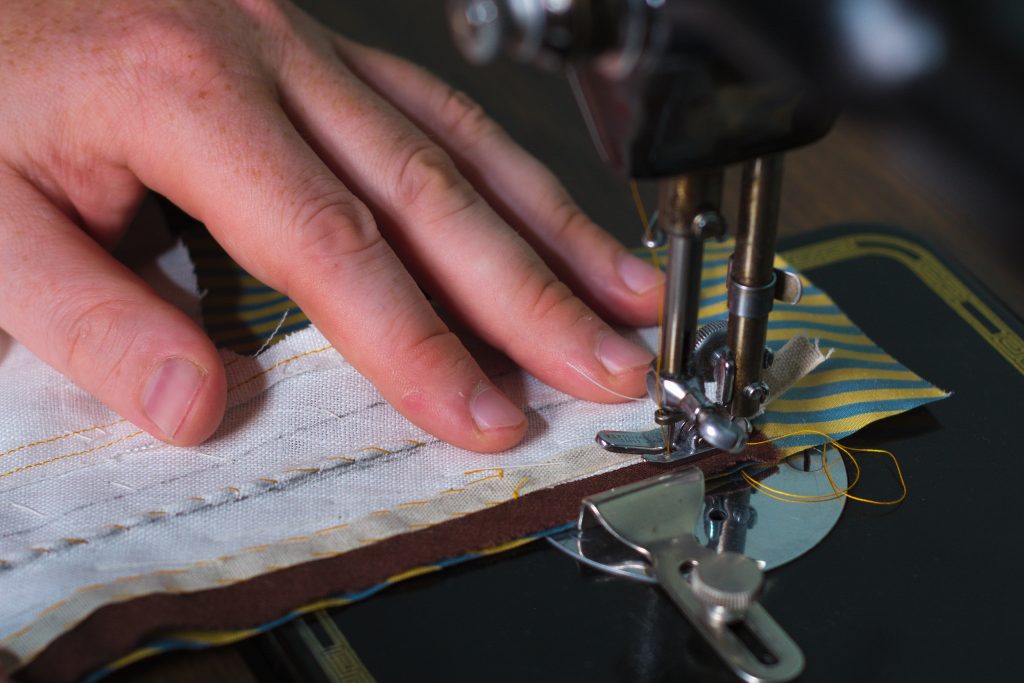
The feed dogs should help the excess facing be worked in evenly at the bottom of the roll line.
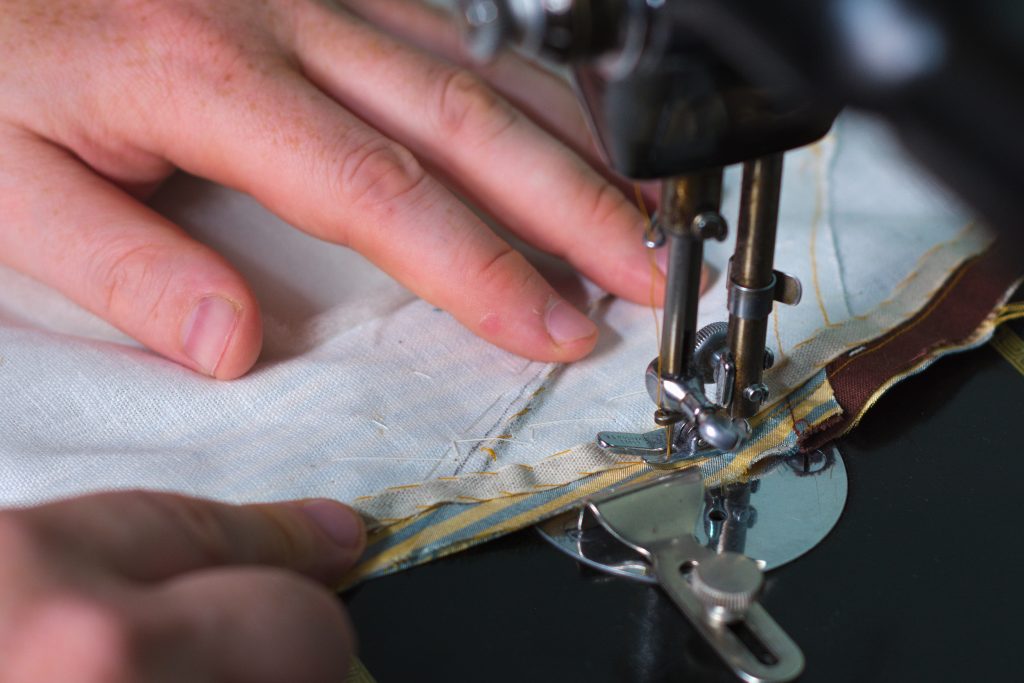
At the bottom of the front seam, instead of turning square across the waist, make a single stitch on the diagonal to make room for the seam allowances after turning right side out. Continue sewing across the waist seam.
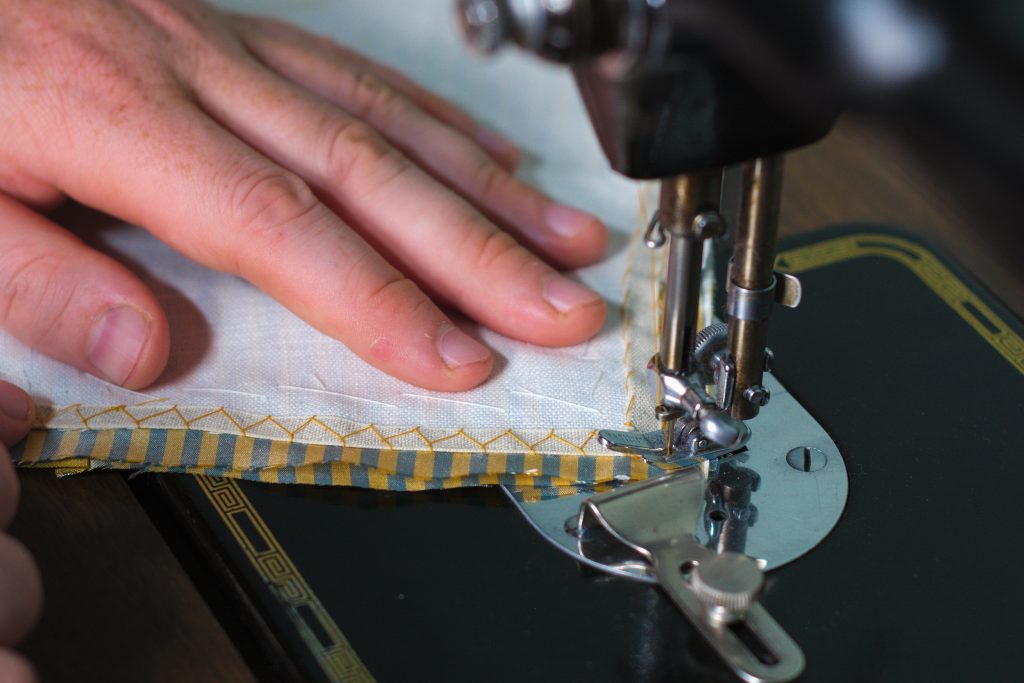
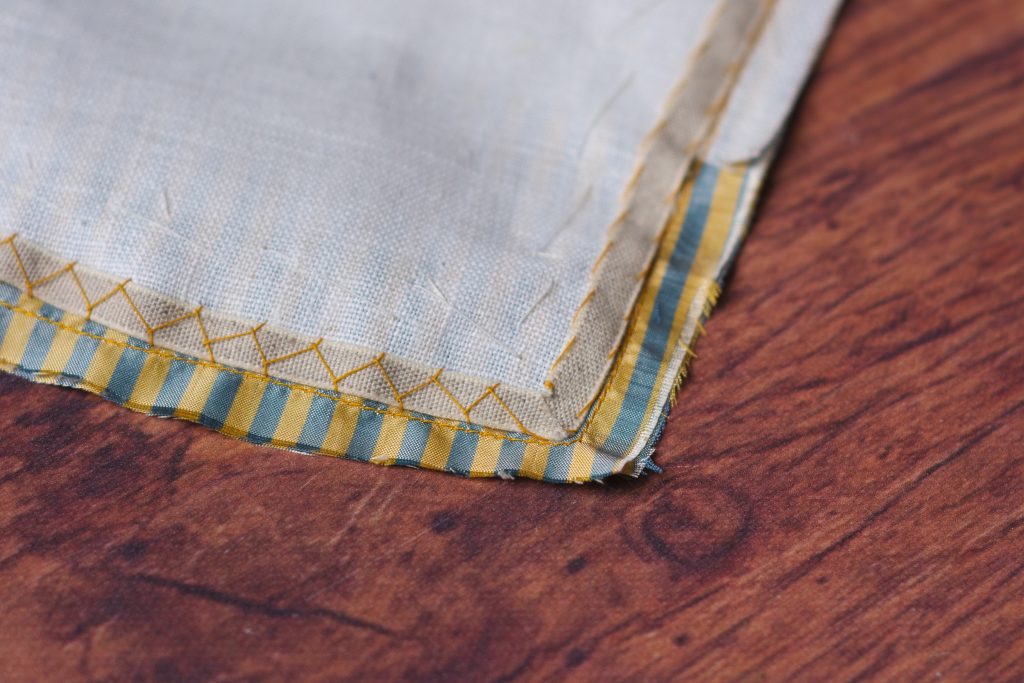
Trim the corner at the center front / waist to about 1/8″.
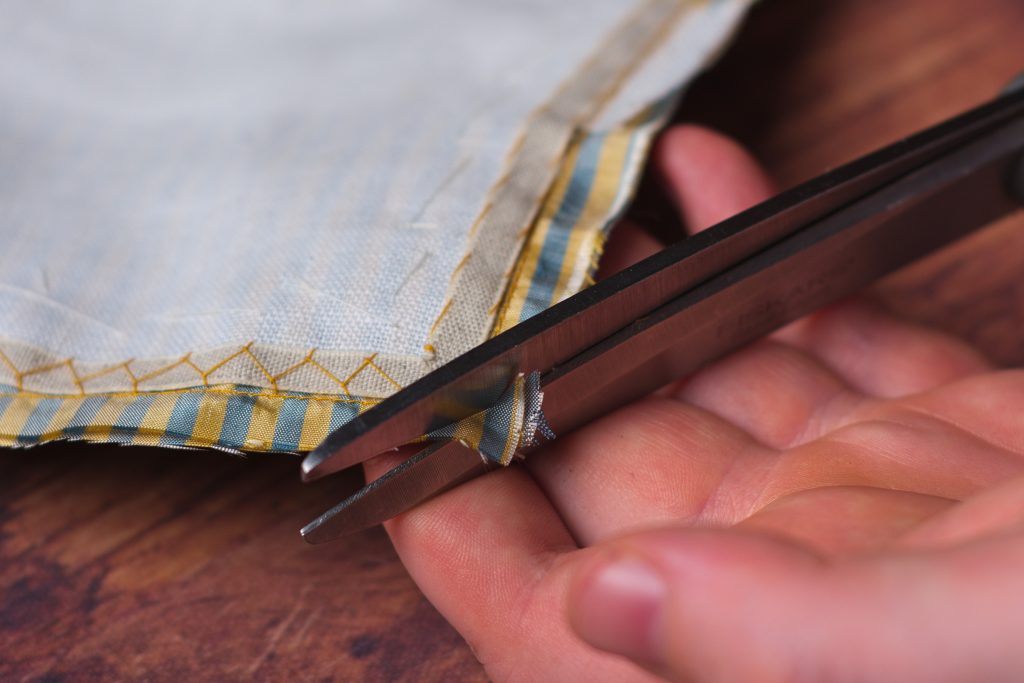
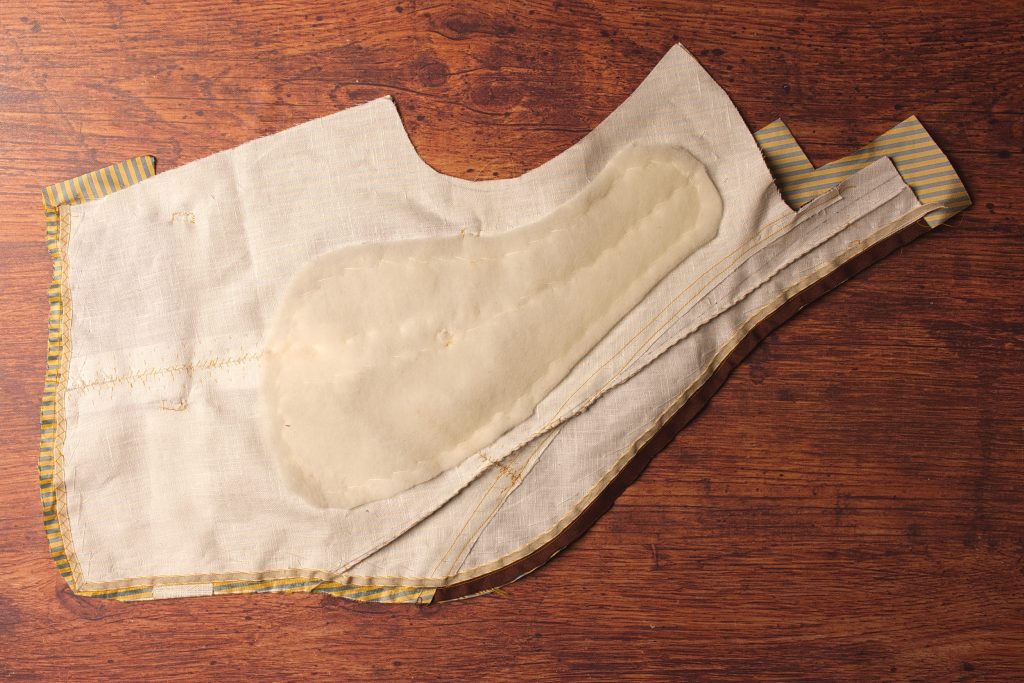
Now remove the basting stitches and carefully turn the forepart right sides out.

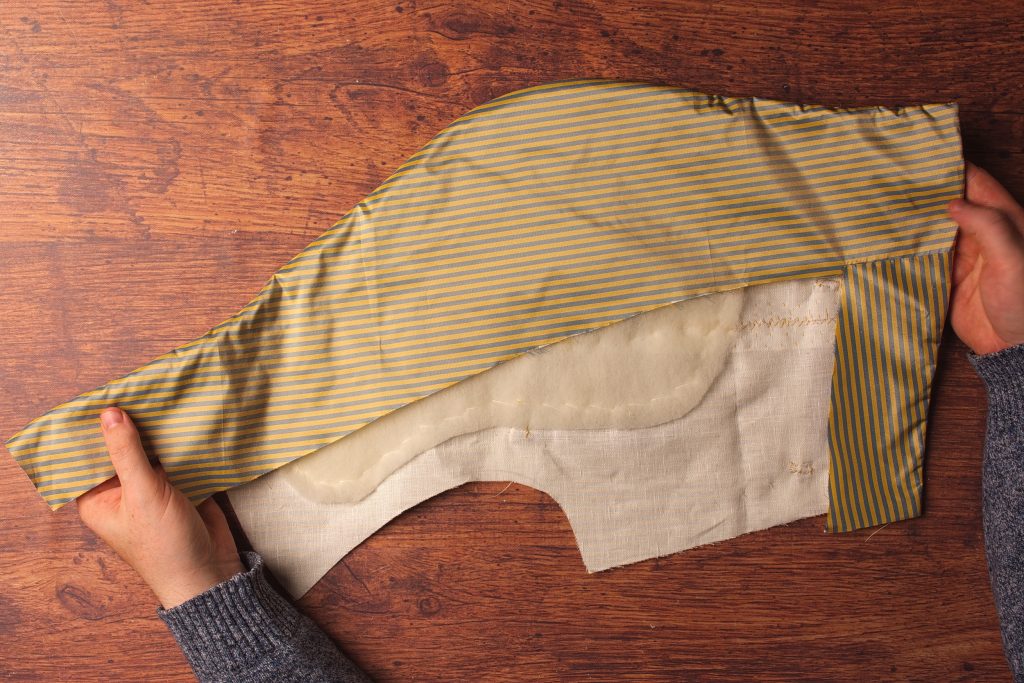
Begin basting the facing in place about 1/2″ from the edge.
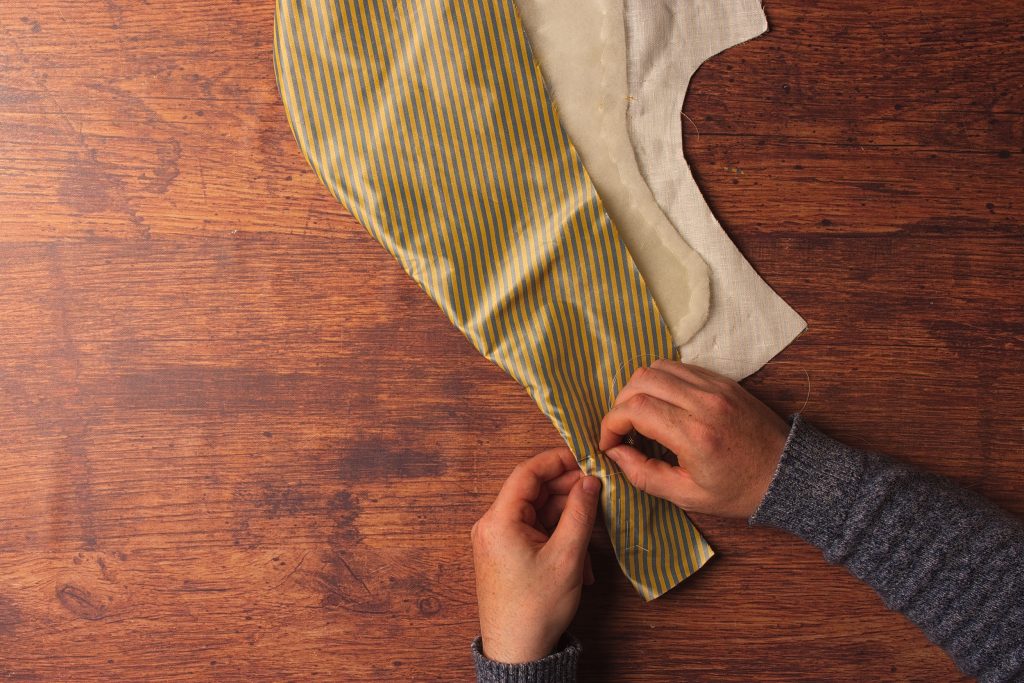
At the collar area, you want to make sure to arrange the fabric so that there is about a 1/16″ to 1/8″ reveal on the underside – so that you don’t see the underside of the collar when wearing.
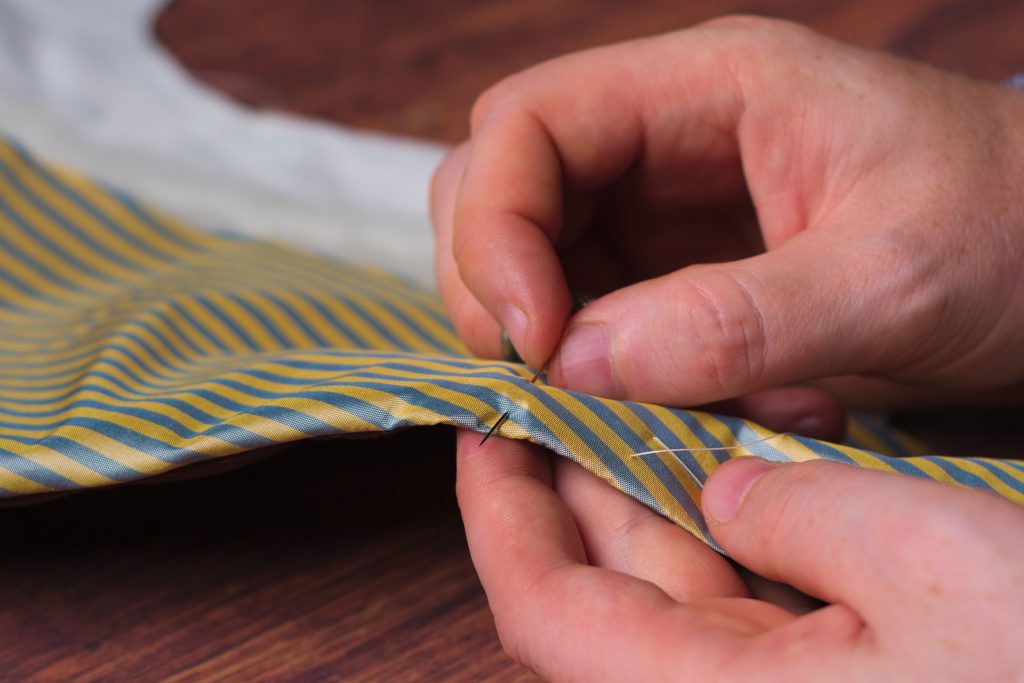
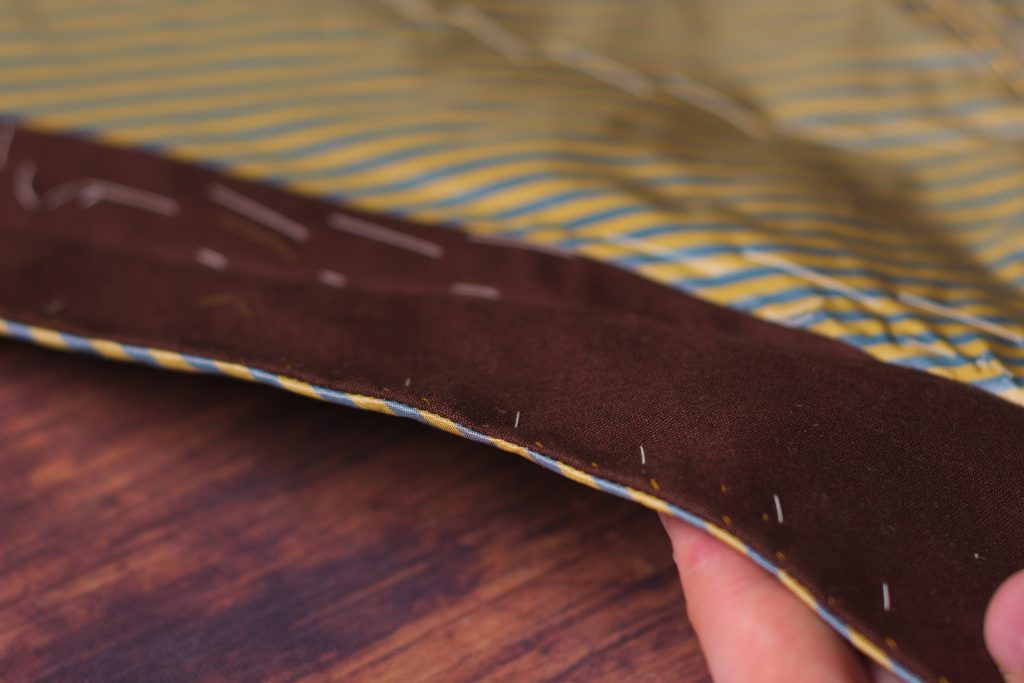
Near the bottom of the roll line, about an inch on either side, keep the reveal even on both sides.
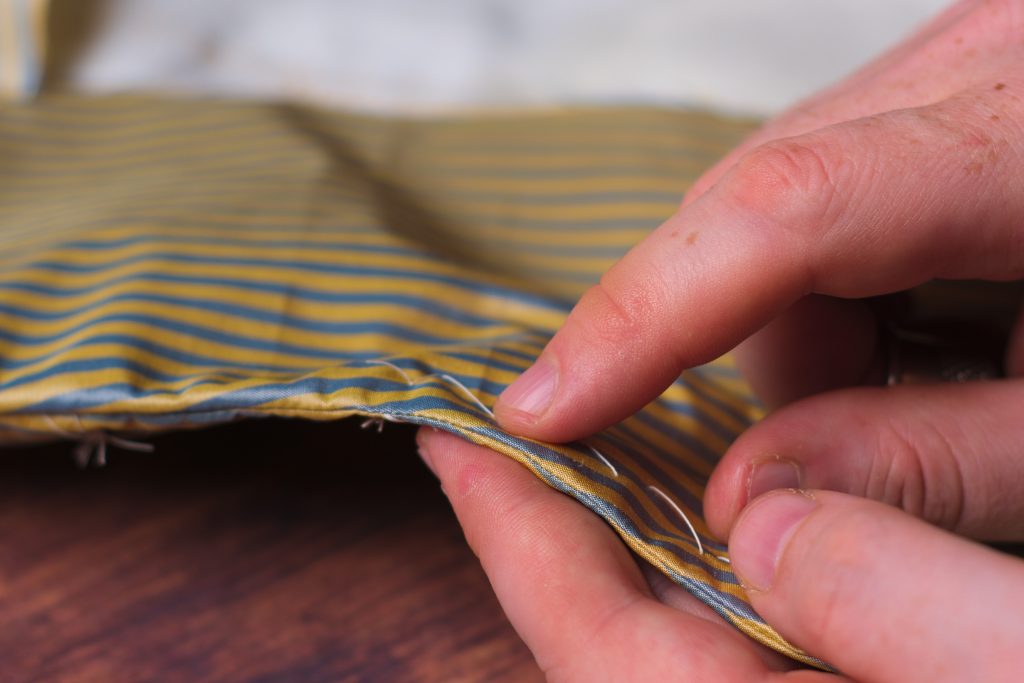
And below the roll line and across the waist, keep the reveal on the facing side so it’s hidden from the right side.
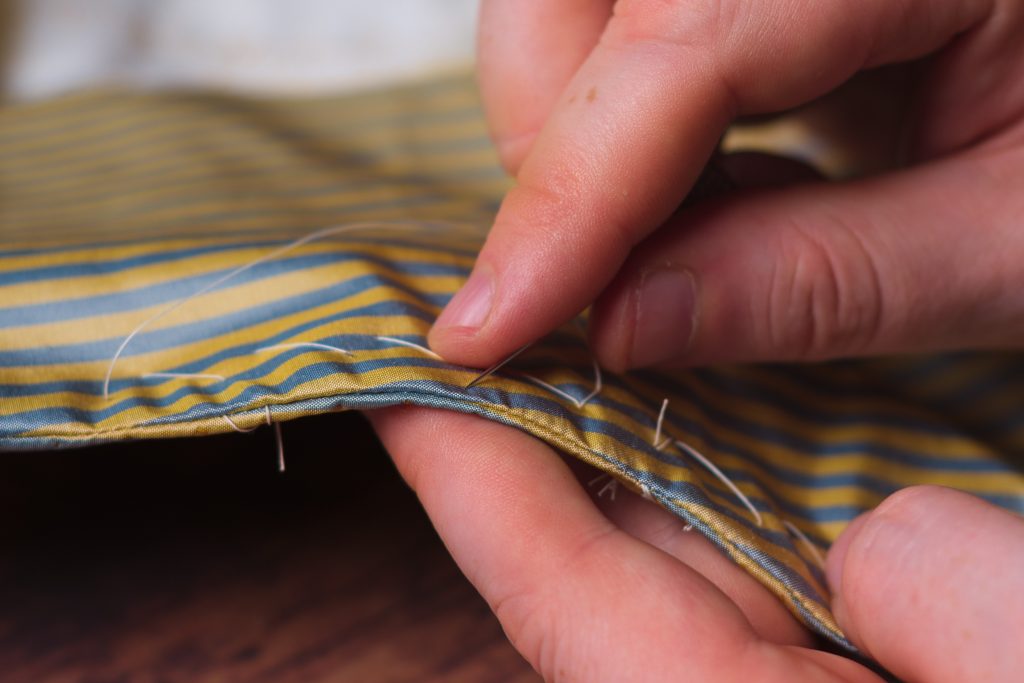
Here’s the collar after basting.
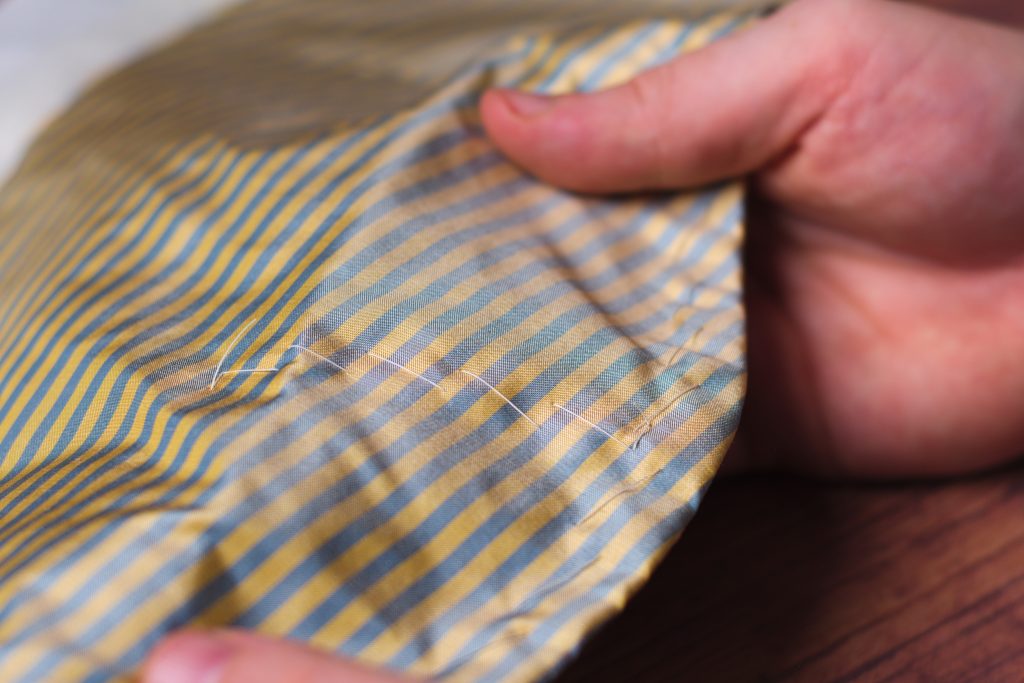
And the forepart in general so far.
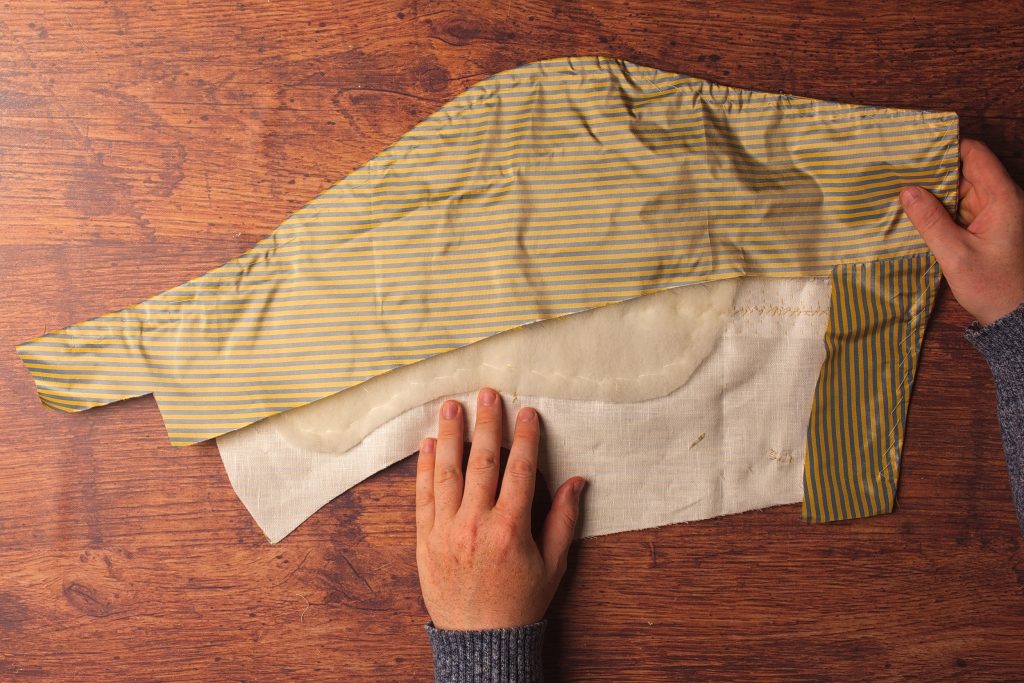
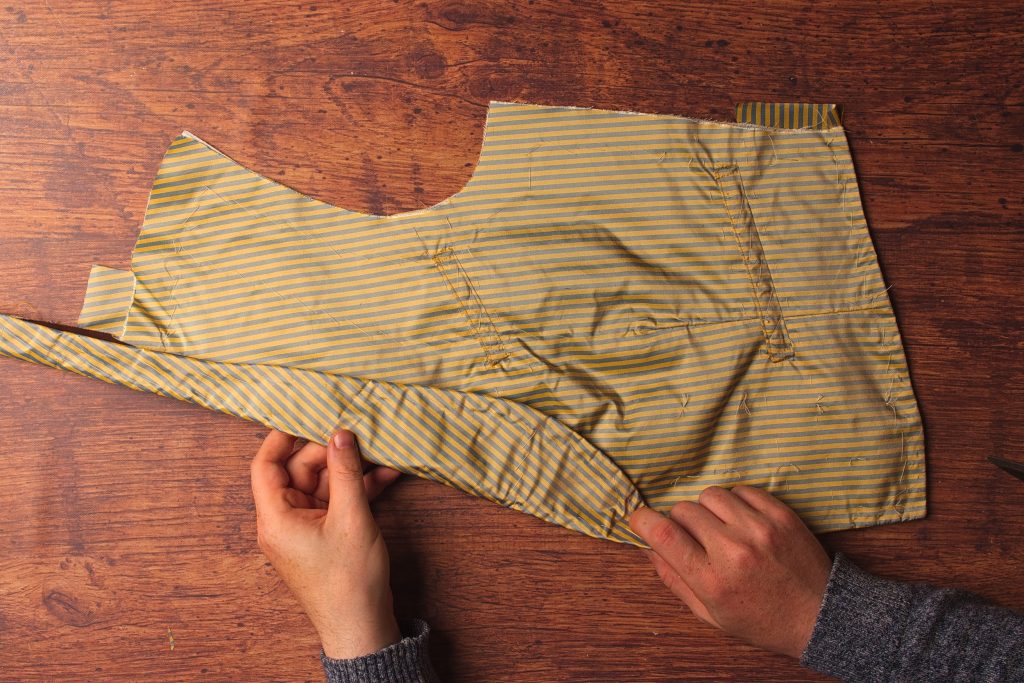
Now we need to arrange the remaining fabric of the facing in a way so that the fullness is properly distributed around the fold of the collar and such. This will help the collar to lay close to the body.
First, open the collar, and with wrong side up, baste from the fullest point of the collar towards the roll line, trying to meet perpendicularly to the roll line, and continue the basting for another half inch or so beyond the roll line.
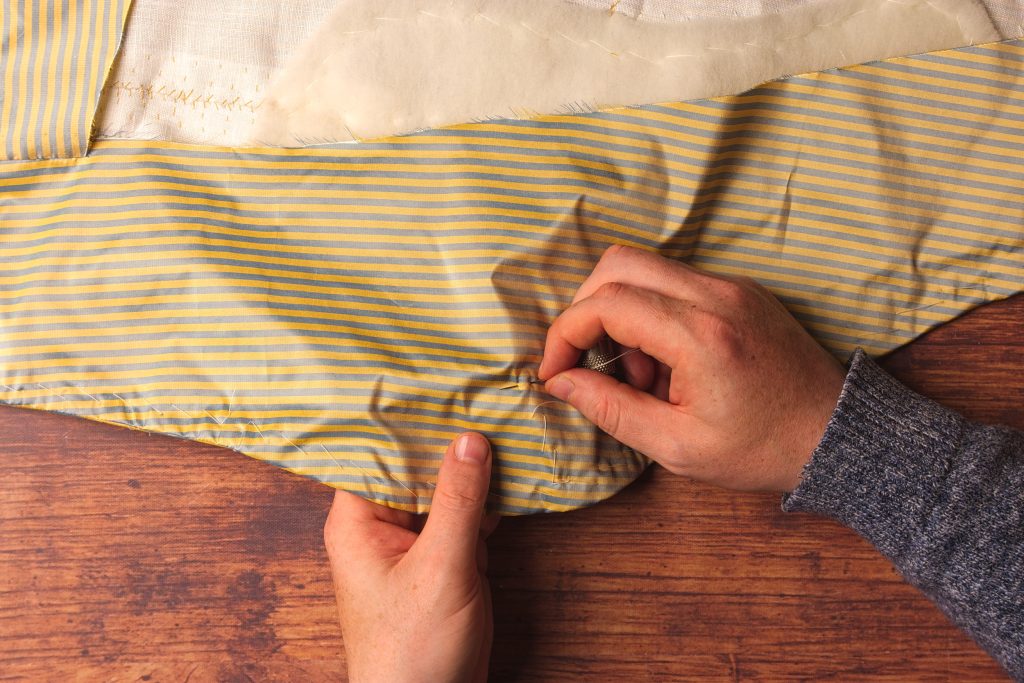
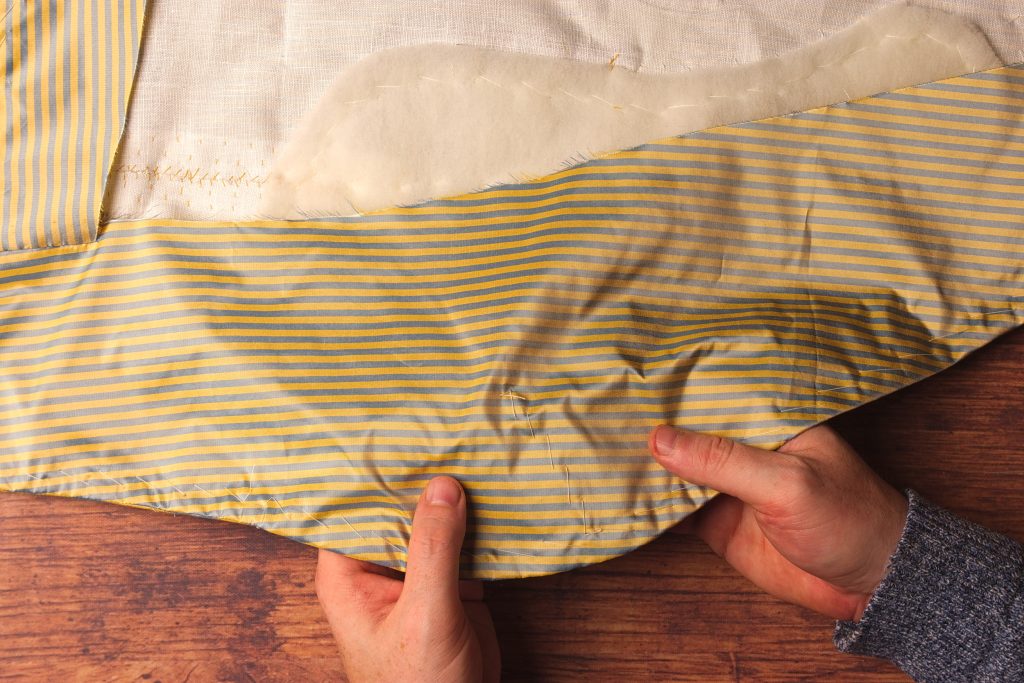
Now turn to the right side and with the collar folded into position, baste about 1/2″ away from the roll line the length of the collar.
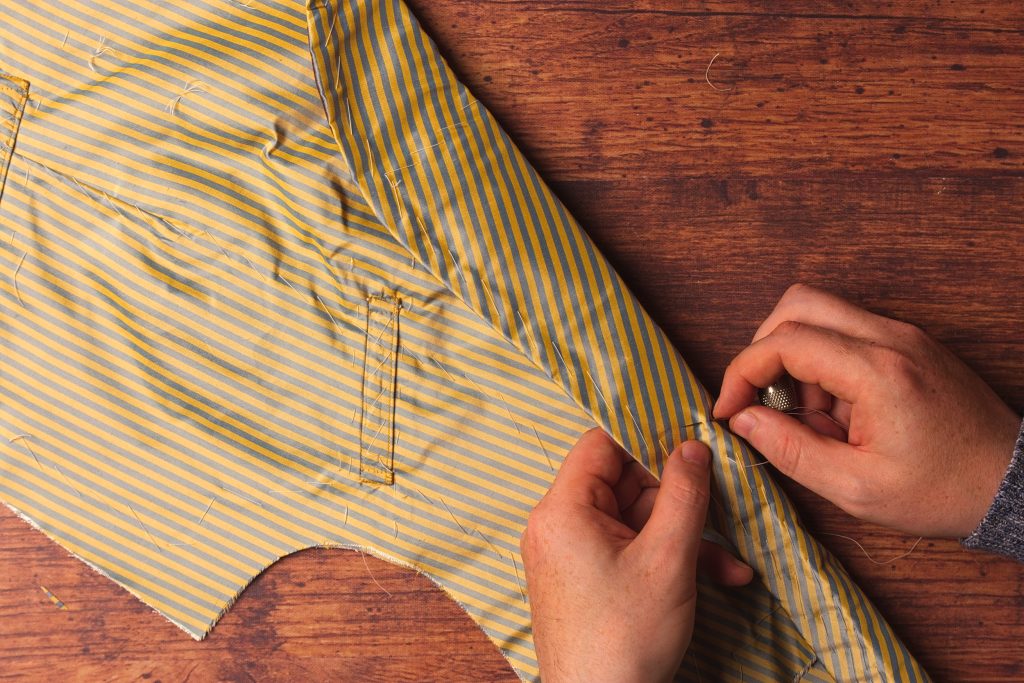
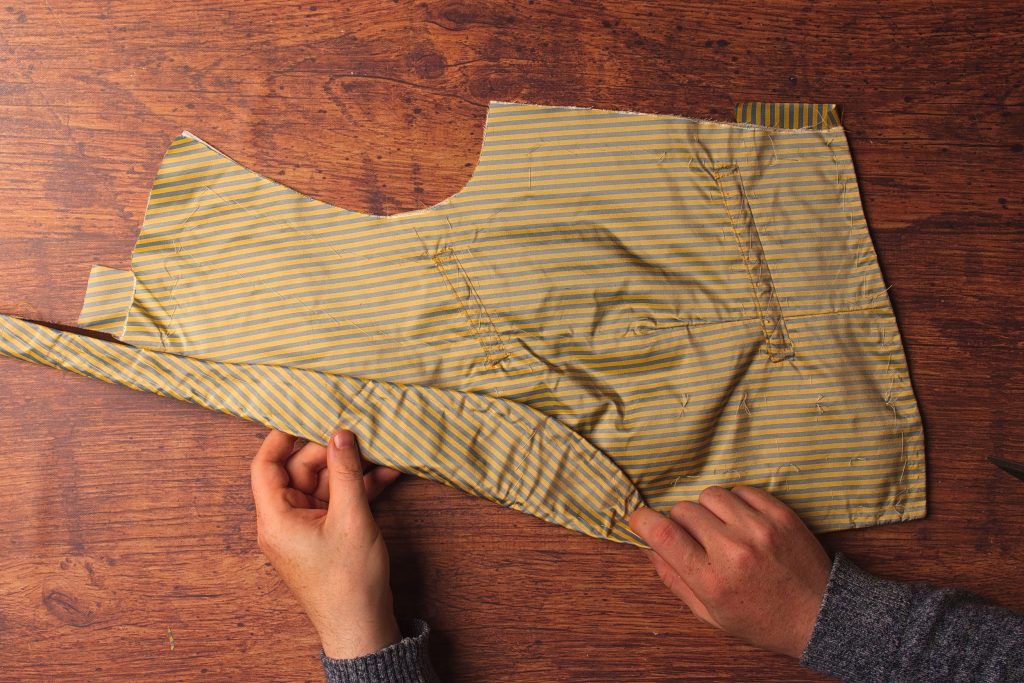
Now I didn’t do this or photograph this step, but if you’re a beginner, I’d recommend turning over the forepart and stitching in the same manner along the other side of the roll line, from the wrong side. This will keep the fabric firmly in position and make this next step a bit easier.
Along the top of the waist piece, baste through all layers about 1/2″ from the edge. Try to keep everything in it’s proper position, no excess or pulling of fabric in any layer.
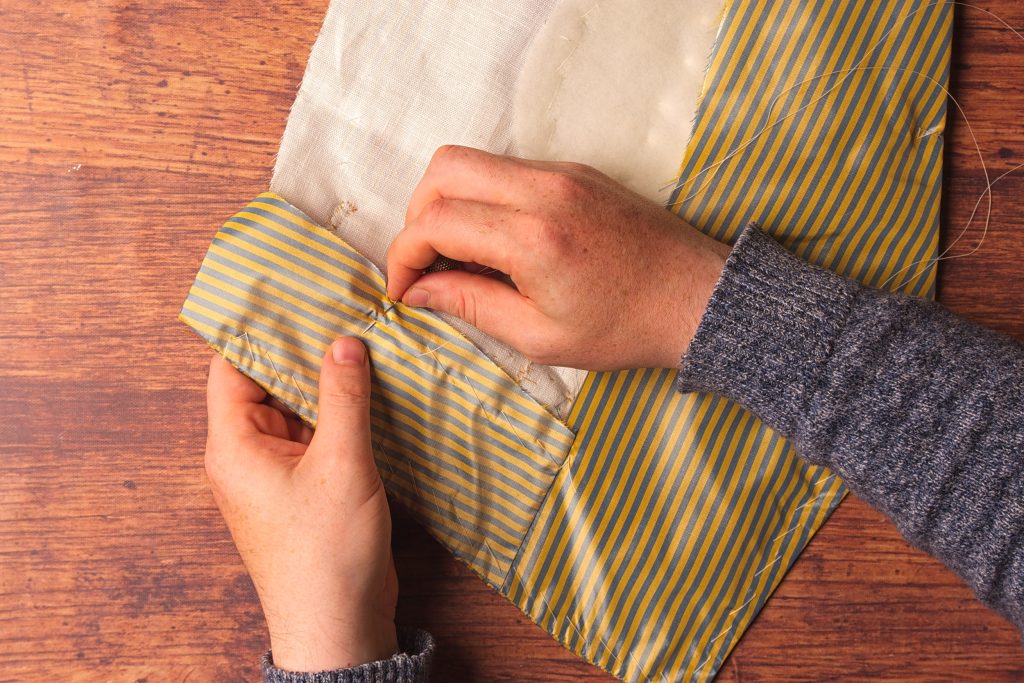
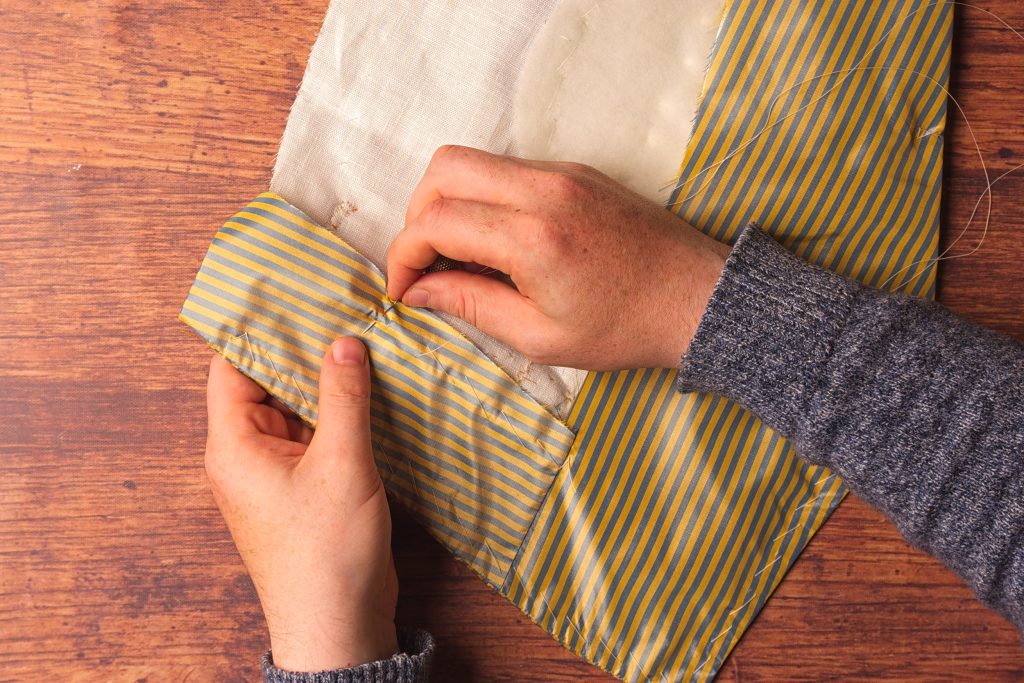
Now turn the forepart to the right side, and using your hand underneath to support the shape and structure, carefully baste the inner edge of the facing along the front. Keep the stitching about 1″ from the inside edge.
Be sure to distribute any fullness equally as much as possible. It’s a little tricky since you can’t really see it as you work, but you’ll get it within a couple of attempts.
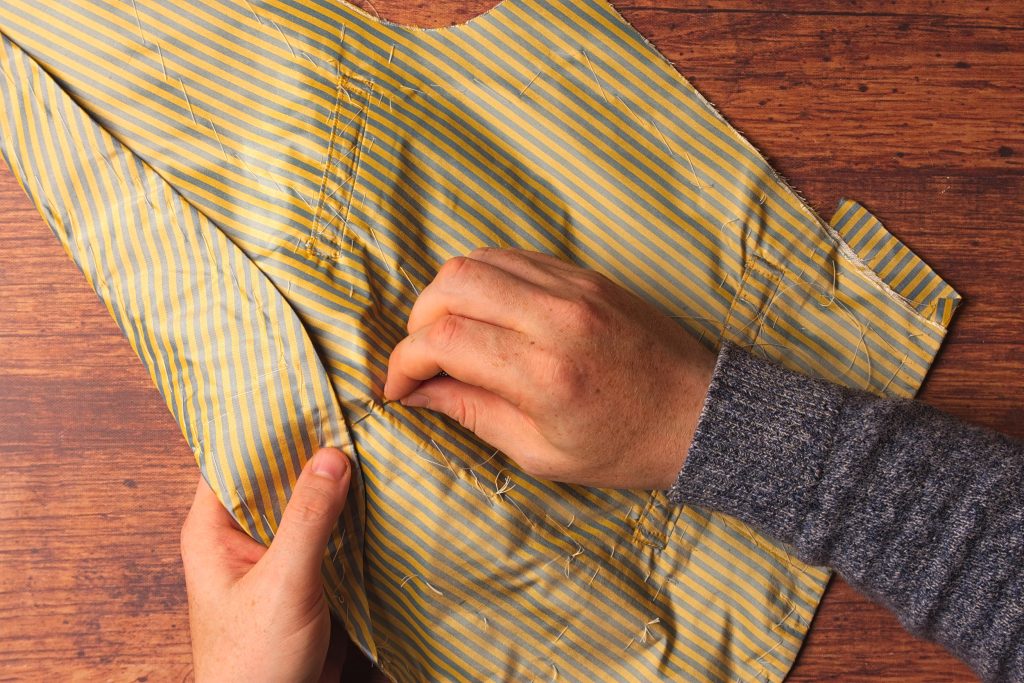
You might have to move the collar out of the way depending on the widths of the collar and facing below it.
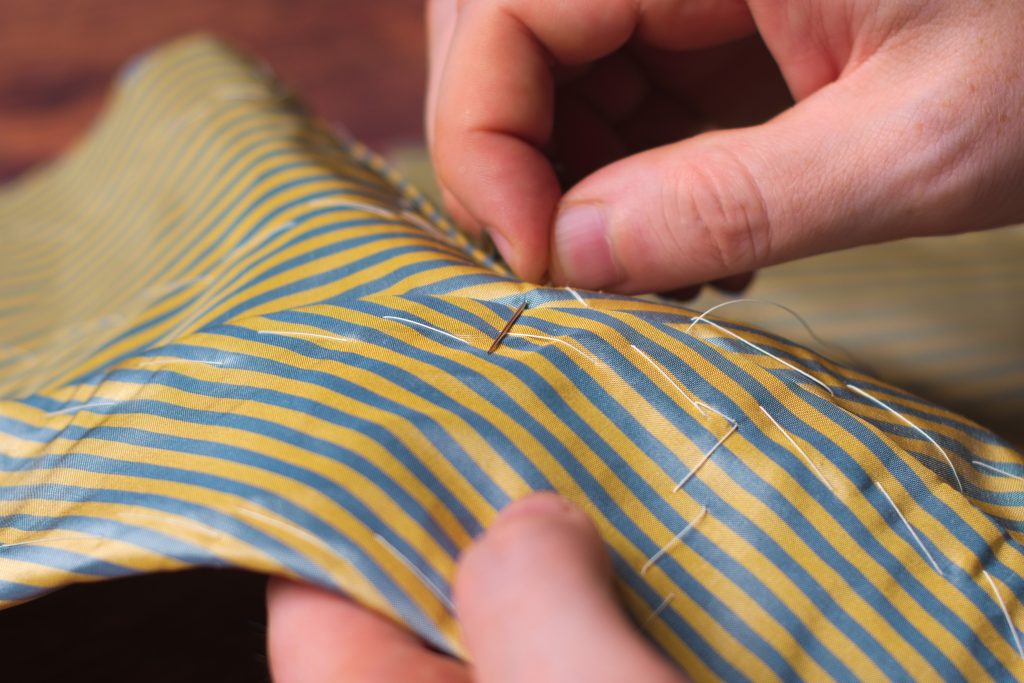
Flipping to the wrong side, take a look at your work and make sure the facing lays smoothly against the forepart. I got one side on the first try, the other side took two tries, so just keep working at it.
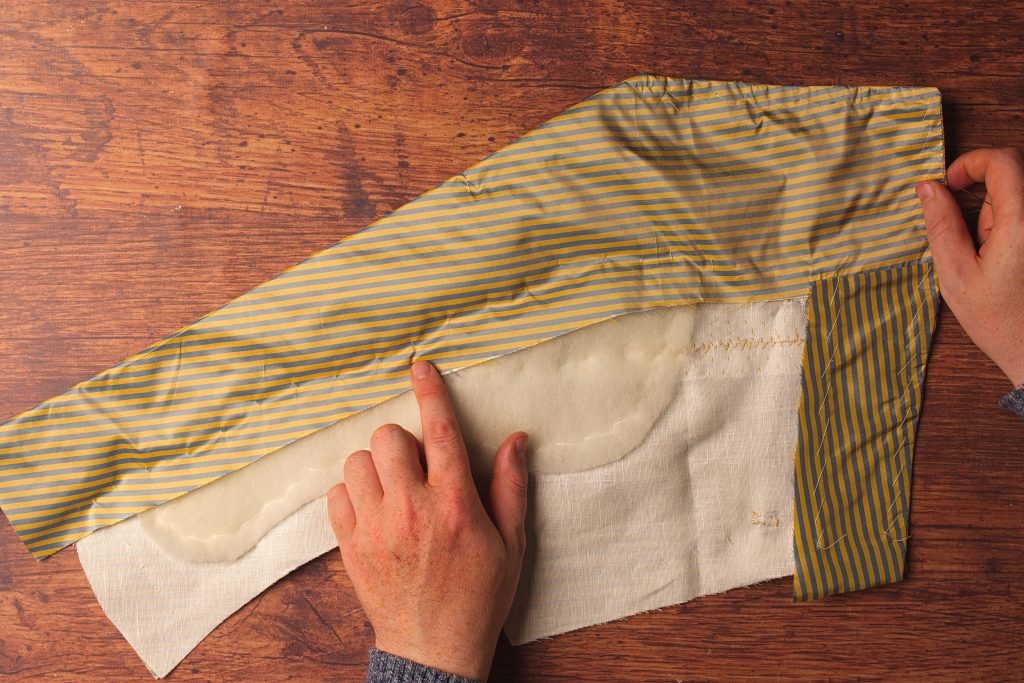
When you’re happy with how everything looks, take some regular sewing thread (not basting thread) and permanently diagonal baste the edge of the facing to the canvas below. Try not to let the stitches show through to the right side. The stitches are about 1/2″ in length and within 1/2″ of the edge.
Baste the waist section as well in the same manner.
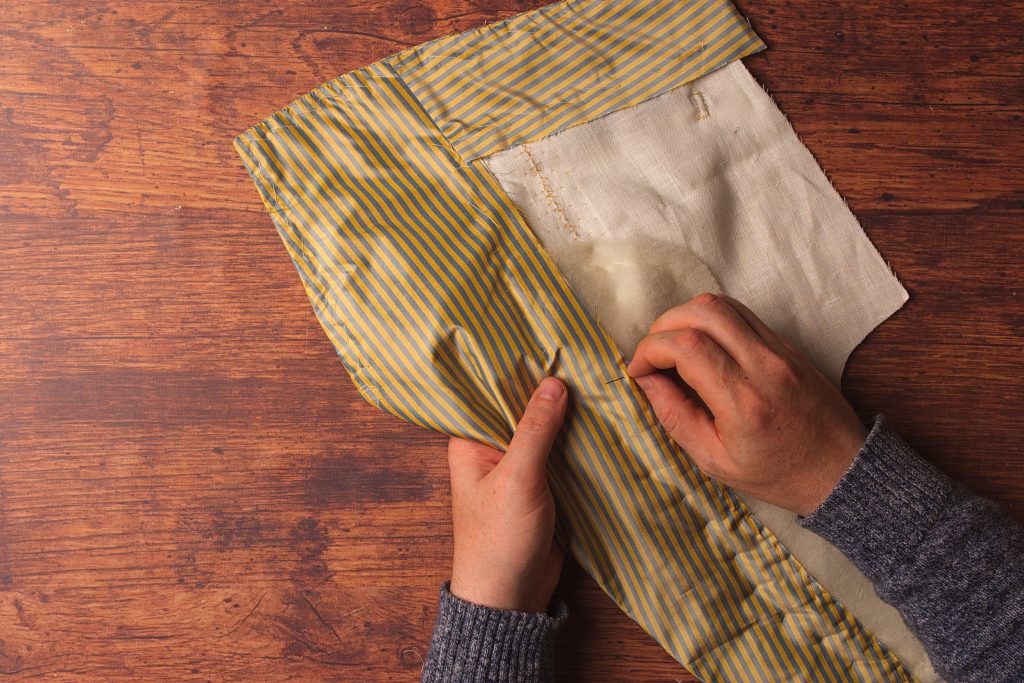

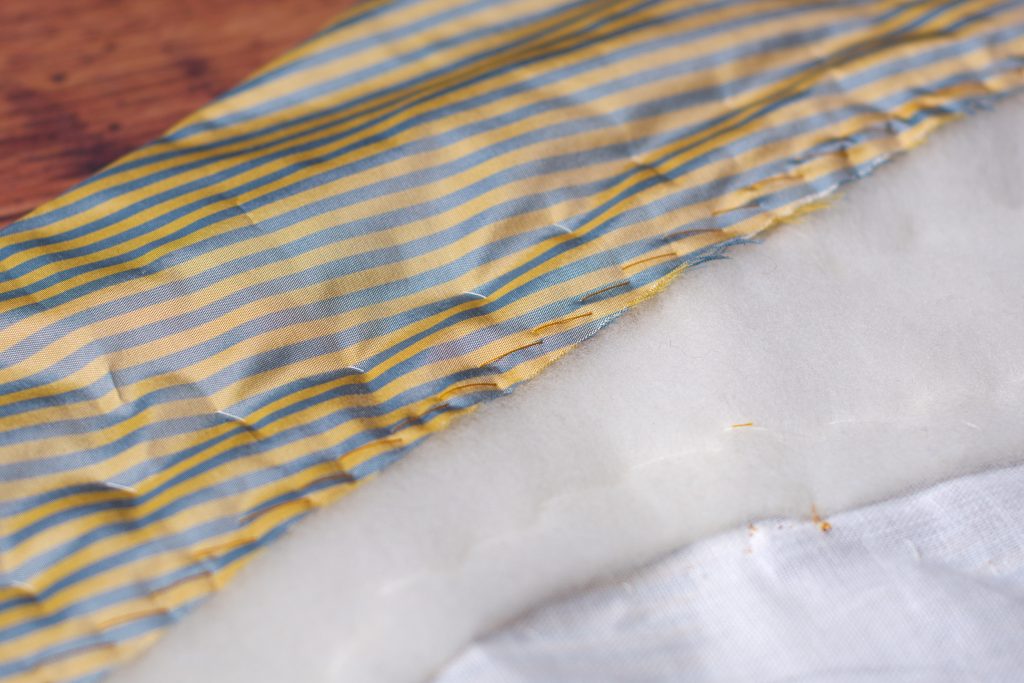
Here’s the completed facing.
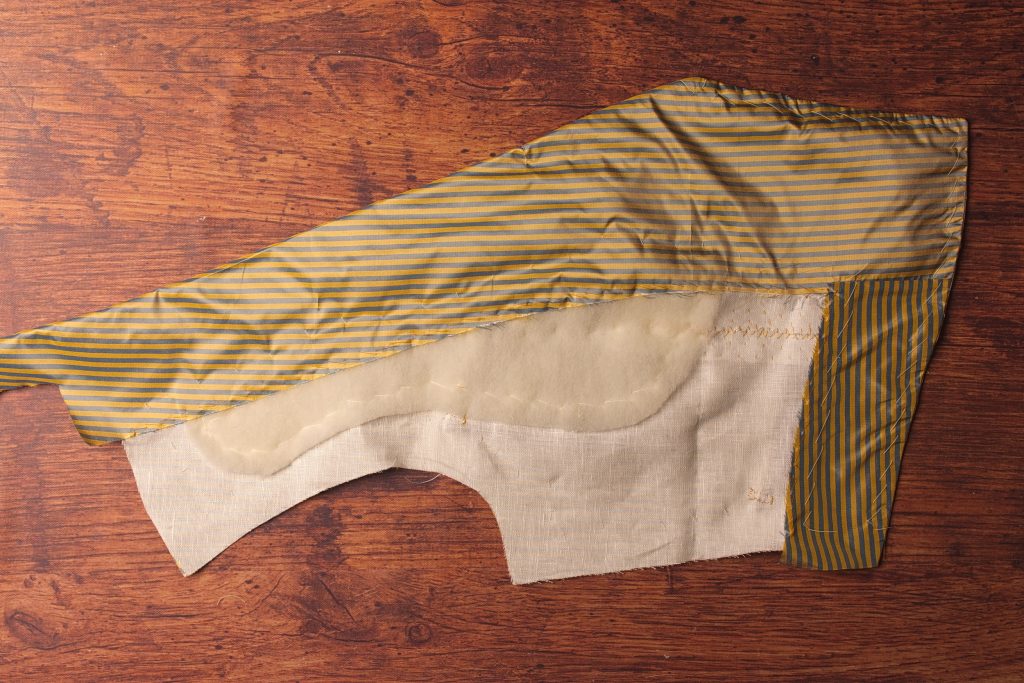
Finally, trim the facings at the shoulder only (keep the excess along the collar), and at the waist area.
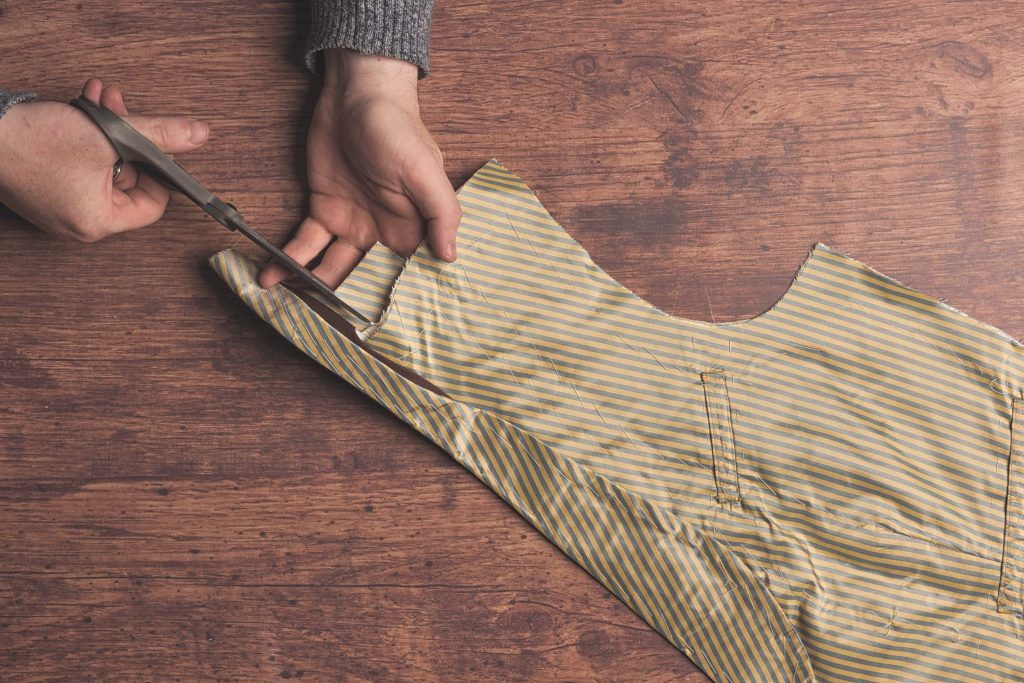
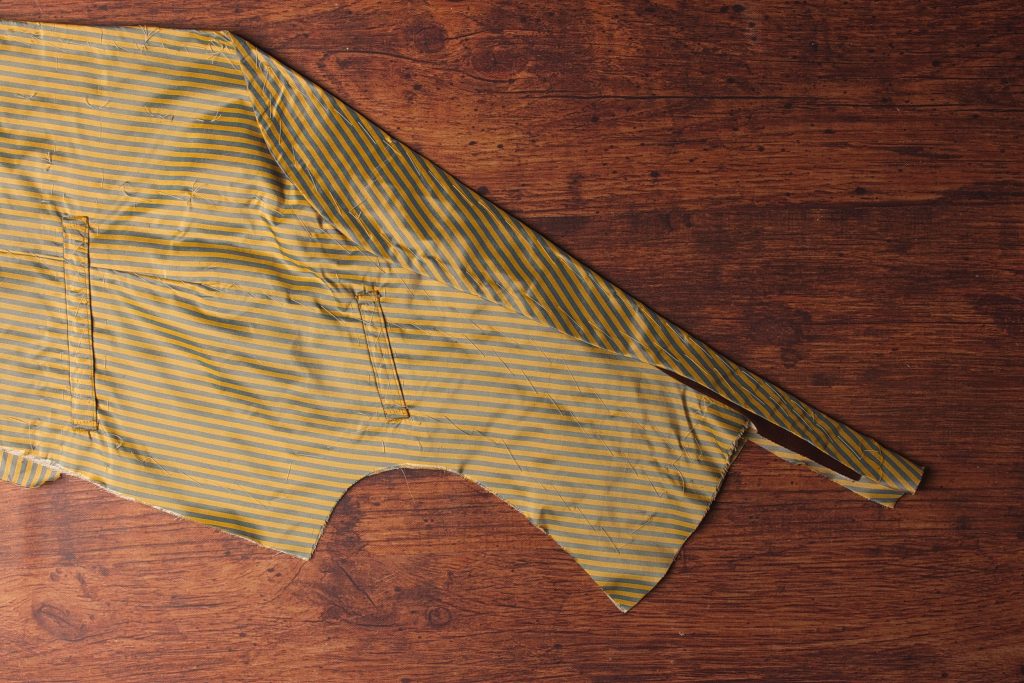
Drafting the Forepart
Moving now onto the forepart draft, square a line down from 0. This can be anywhere to the left of the back piece depending on how much room you have on your paper – I moved it over a bit to make things a little clearer.
Square down from 0 the following points:
- 4 graduated inches from 0 for the shoulder angle and neck point.
- 7 1/2 graduated inches from 0(this should already be marked from the back and hopefully correspond) for the armscye width.
- 10 graduated inches from 0 for the bottom of the armscye and width of the chest.
These next points can be followed if you kept the 17 1/4 graduated inches for the natural waist length – if you altered that to correspond to your actual measurement skip this section and follow the next diagram. These points help form the side body.
- 18 1/2 graduated inches from 0.
- 19 3/4 graduated inches from 0 should already be marked from the back.
- 21 3/4 from 0 for the bottom of the side body.
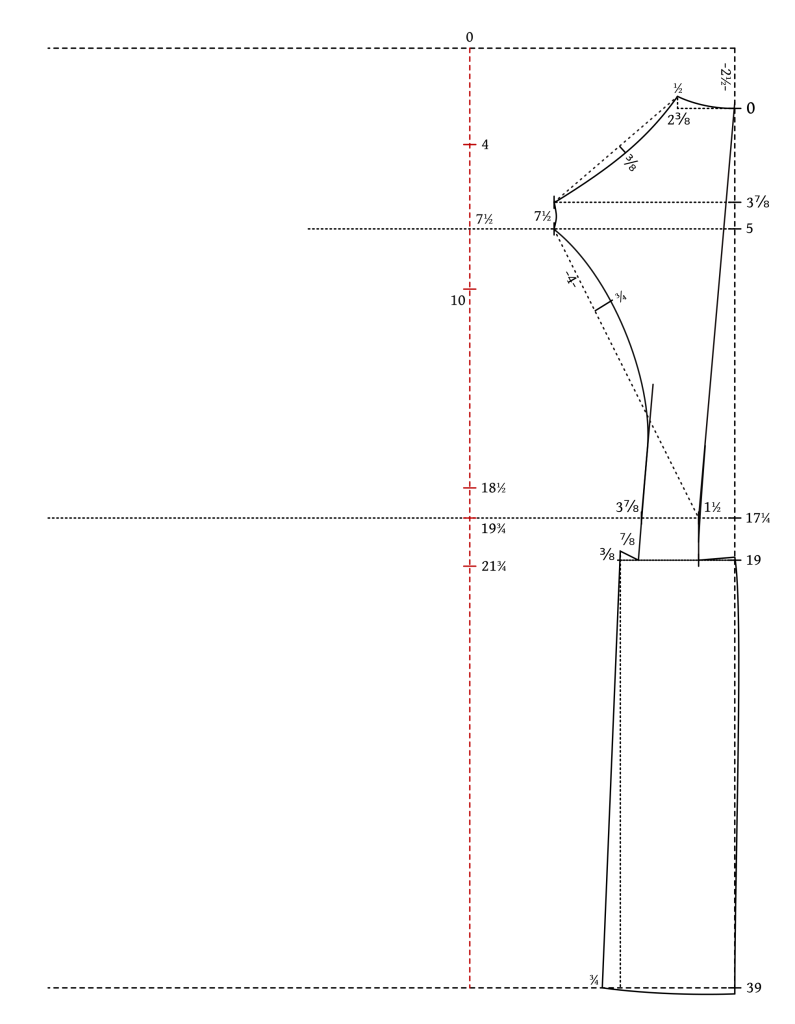
If you did alter the waist length, simply measure out the following points from the natural waist line instead. This should help ensure all the lengths agree with each other.
- Measure up 1 1/4 graduated inches.
- Measure down 2 graduated inches.
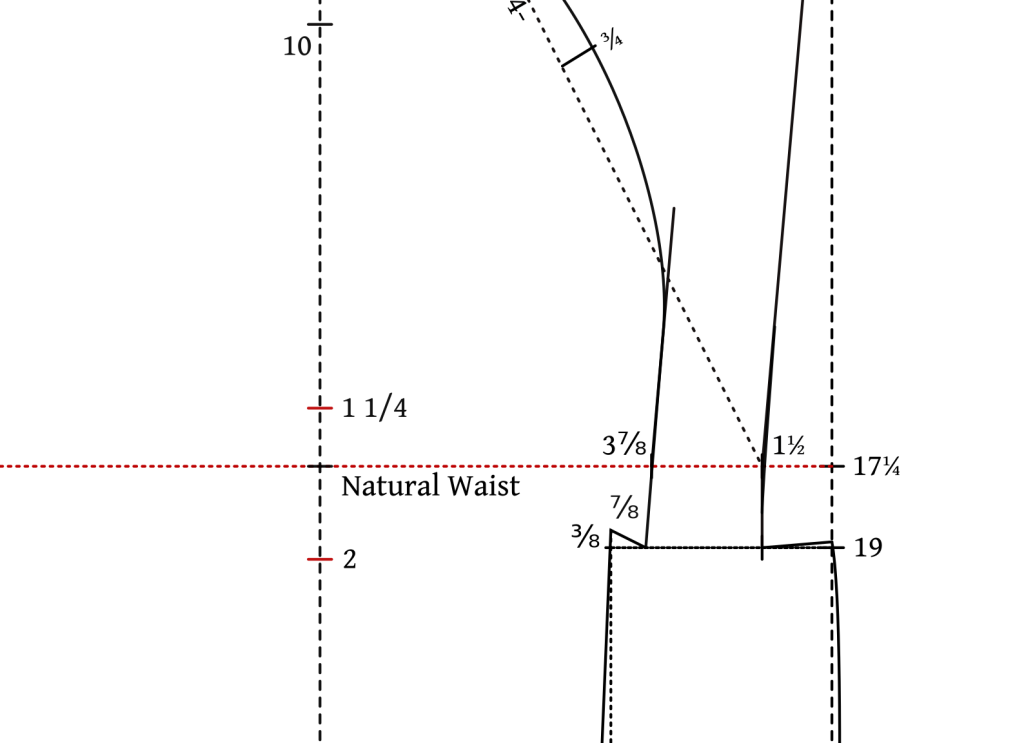
Square out and mark the following widths:
- 10 1/4 graduated inches from 0 for the shoulder point.
- 17 1/2 graduated inches from 0 for the overall width. Square down from 17 1/2.
- 16 graduated inches from 4 for the neck point. This may be altered later to adjust the width of the lapels.
- 1 1/2 graduated inches from 7 1/2 for the side body point.
- 6 3/4 graduated inches from 7 1/2 for the width of the armscye.
- 4 3/4 graduated inches from 10 for the bottom of the armscye. Square this line all the way across.
- 5 3/4 graduated inches from 18 1/2 for the bottom of the side body seam.
- 16 1/2 graduated inches from 19 3/4 for the waist opening.
- In the opposite direction on this same line, measure 2 1/4 graduated inches from 19 3/4.
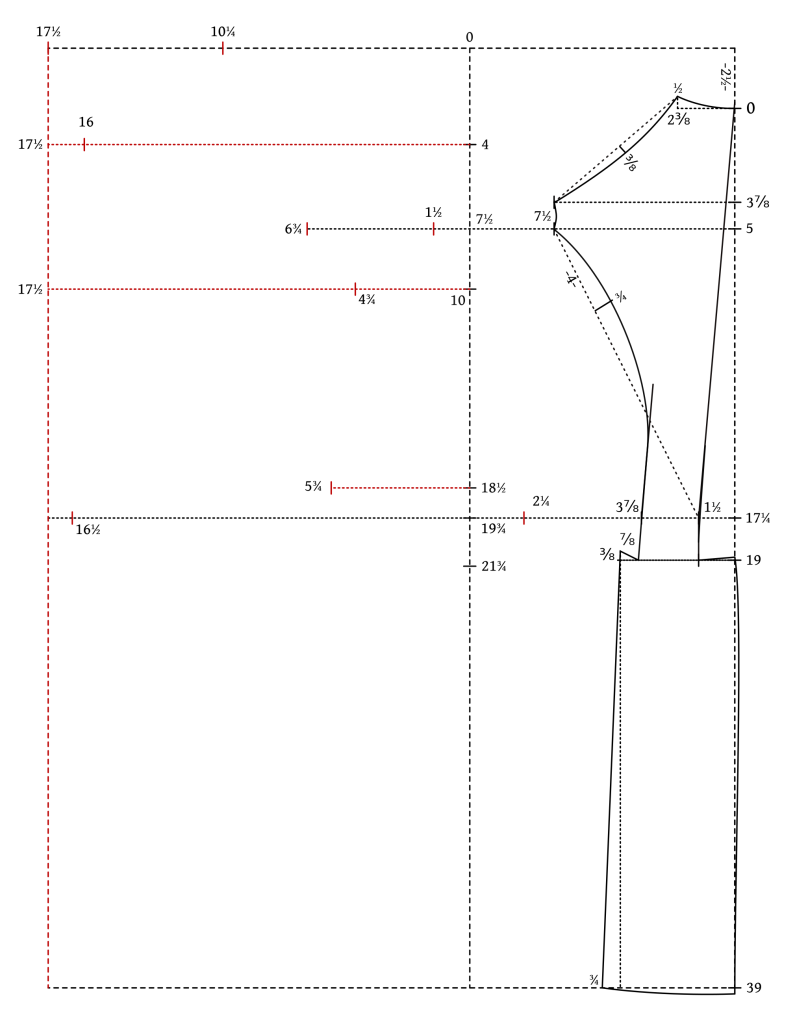
Now we’ll draw some more construction lines to aid in drawing the various curves. Draw lines from:
- 10 1/4 to 4 for the shoulder seam.
- Measure the back shoulder seam from 7 1/2 to 1/2 (along the straight construction line). Apply this exact measurement from 10 1/4 to find X.
- 16 to 10 1/4 for the neck seam.
- X to 6 3/4 to 4 3/4 to 1 1/2 for the armscye.
- 16 to 17 1/2 to 16 1/2 to the bottom corner of the draft for the front of the coat.
- 4 3/4 to 5 3/4 for the side seam. Continue the line through 5 3/4 to the waist line to aid in drawing out the curves in the next step.

Square out the following lines to find the depths of the curves:
- First find one-third of the distance from 10 1/4 towards 16. Square in 1 1/8 graduated inches.
- From the center of 10 1/4 to X, square out 5/8 of a graduated inch.
- From the center of X to 6 3/4, square in 1/2 of a graduated inch.
- From the center of 6 3/4 to 4 3/4, square in 7/8 of a graduated inch.
- From the center of 4 3/4 to 1 1/2, square in 3/4 of a graduated inch.
- On the main construction line from 0, measure 4 graduated inches below 7 1/2. Square out 3/4 of a graduated inch.
- At the bottom of the side seam from 4 3/4 to 5 3/4, where it intersects the waist line, mark 1/2 of a graduated inch on either side. You could extend this to 3/4 if you find you need a bit more room.
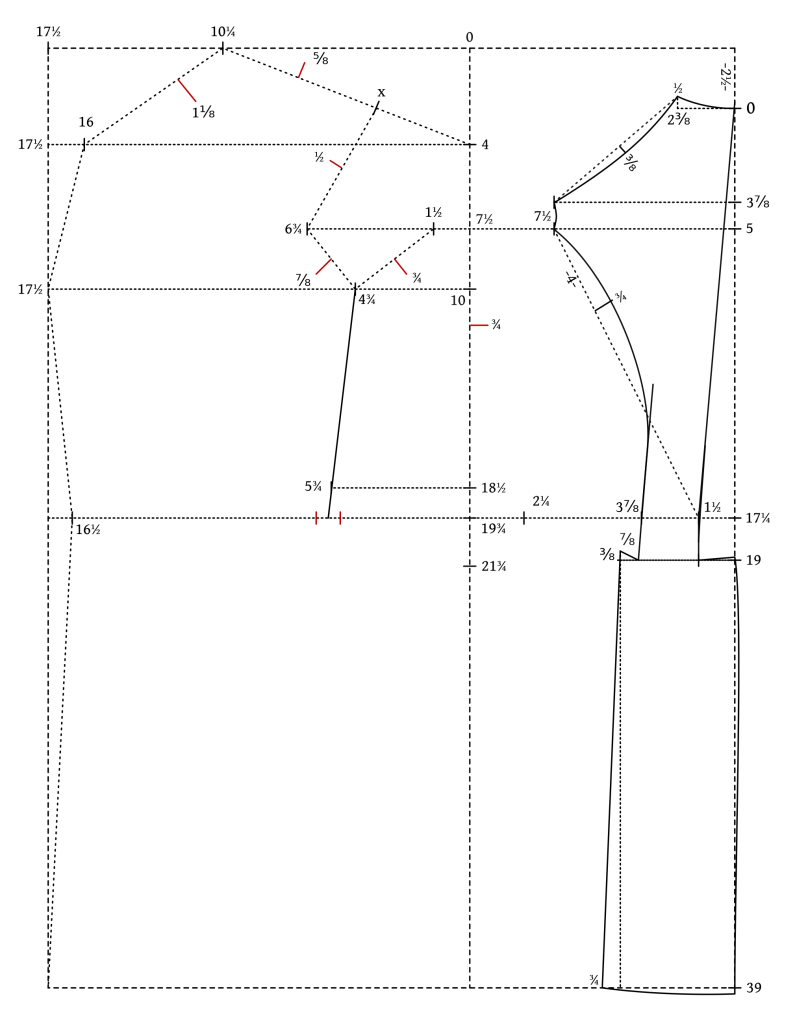
Now draw the following curves.
- Shoulder seam from 10 1/4 through 5/8 to X.
- Armscye from X through 6 3/4 — 4 3/4 — to 1 1/2.
- Neck seam from 10 1/4 through 1 1/8 to 16.
- Shape the front edge with a graceful curve from 16 through 17 1/2 and 16 1/2. The curve reverses direction at the waist.
- Draw the side body seam from 1 1/2 through 3/4 to 21 3/4. It’s a compound curve again and kind of reverses direction just above 18 1/2, though it’s not actually running through points 18 1/2 and 19 3/4.
- At the bottom of the side seam, an inch or so above 5 3/4, draw to curves to the points on the waist line to help spring out the waist and make room for the hips. This is a little confusing as the curve on the left is for the side body and the curve on the right is for the forepart.
- Complete the bottom of the forepart by drawing a straight line from the left point beneath 5 3/4 to 21 3/4.
- Finally, for the curved bottom edge at the center front, measure equal distances from the main intersection – I did 4 graduated inches. The draw a curve as shown. Using a plate or something round can be helpful here.
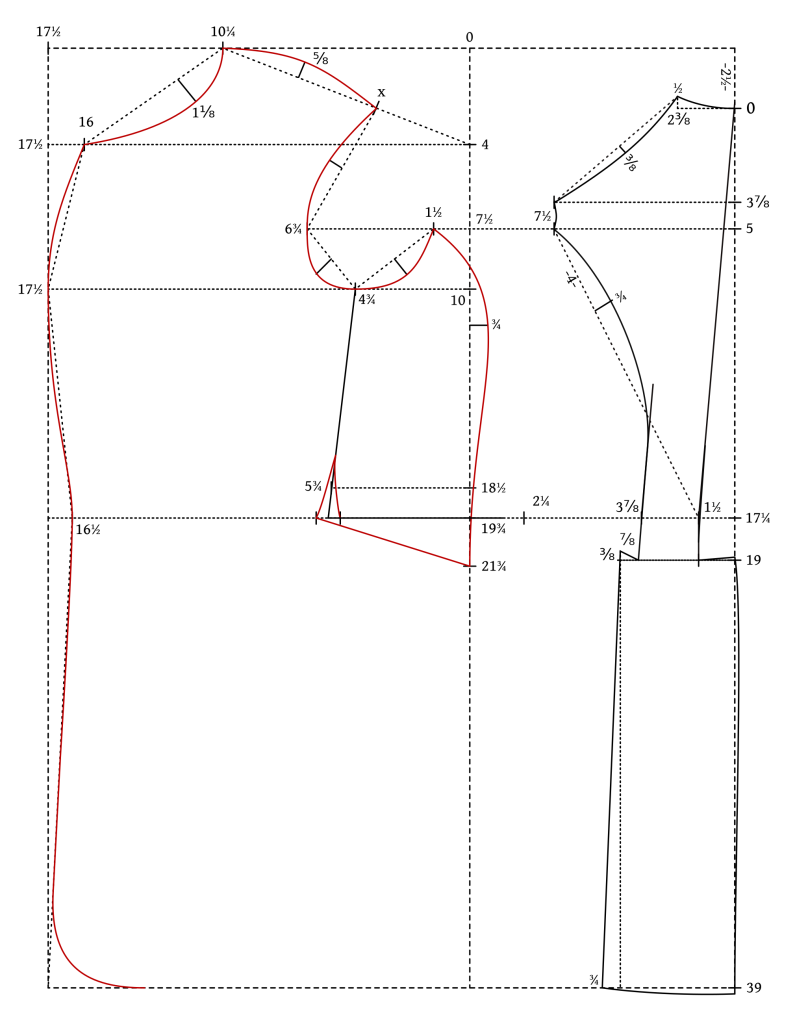
To finish off the main part of the draft, we’ll finish up the front skirt.
- Draw a line from the bottom of the side seam where it curves to the right (it’s along the waistline so it’s technically already drawn) to 2 1/4.
- Spring up the last 7/8 of the line by 3/8 graduated inches as shown to match the spring in the back waist.
- Draw a line down from 2 1/4 at a similar angle to that shown – about 30 degrees from vertical is a good starting point. Make this line the same length as the corresponding seam on the back skirt. You’ll probably get some overlap of the forepart onto the back but it’s nothing to worry about – easy to copy each piece onto a separate sheet of paper.
- If you want or need more fullness in the skirt you can raise that first skirt line up by about 1/2 graduated inch and spring out the back skirt seam even more as necessary.
- Finish up the draft by drawing a very slightly curved seam along the bottom edge of the skirt. It should be at 90 degrees to the back of the skirt and taper gracefully into the curve at the center front.
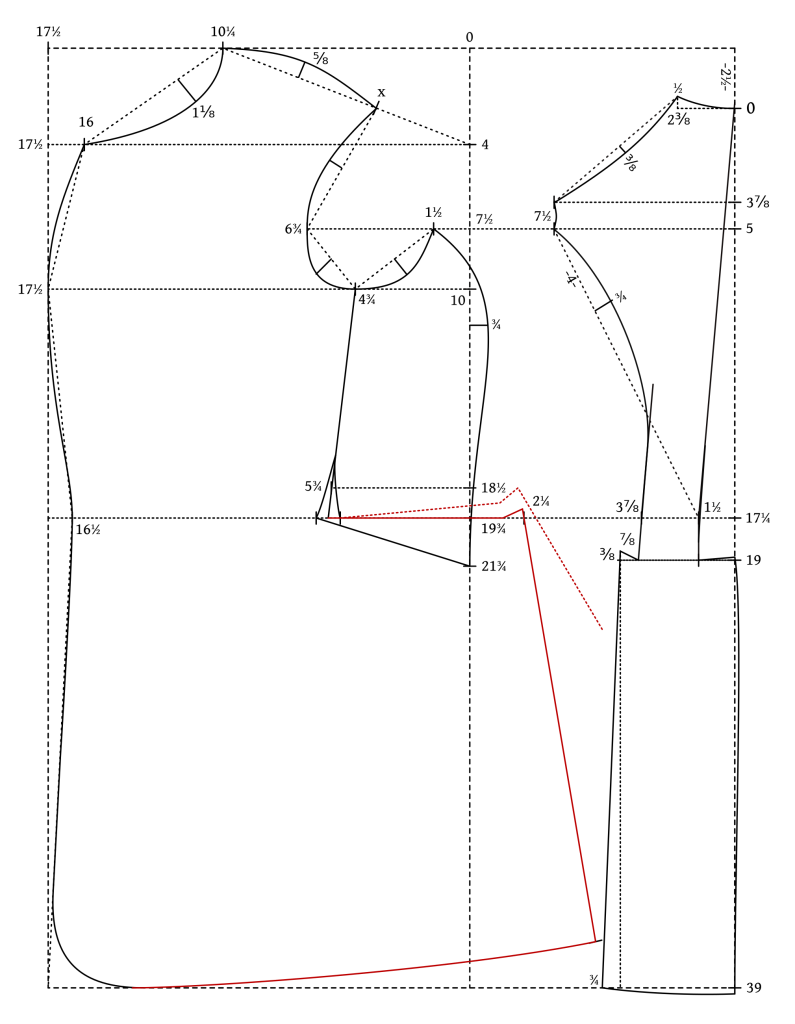
Drafting the Back
We’ll begin drafting, as usual, with the back of the coat. First, draw a square horizontally and vertically. This should be wide enough to fit the coat and the a little longer than the total length, but of course you can simply extend the lines if necessary later on.
All measurements should be in graduated inches, corresponding to your chest size, unless otherwise noted. Also, I’m using dashed lines here to denote construction lines but in practice I just use a solid pencil line for everything.
From the intersection, measure 2 1/2 graduated inches down and mark 0. The back lengths are all measured from this 0 point rather than the intersection.
- 3 7/8 graduated inches from 0 for the rear shoulder point.
- 5 graduated inches from 0.
- 5 graduated inches from 0.
- 17 1/4 graduated inches from 0 for the natural waist. I highly recommend checking this to your actual measurement in inches just to compare the two.
- 19 graduated inches from 0 for the dropped waist common during the 1860s.
- 39 graduated inches from 0 for the total length of the jacket. Devere gives 39 here but it’s quite likely too long, especially for larger chest sizes, so use your actual measurement here.
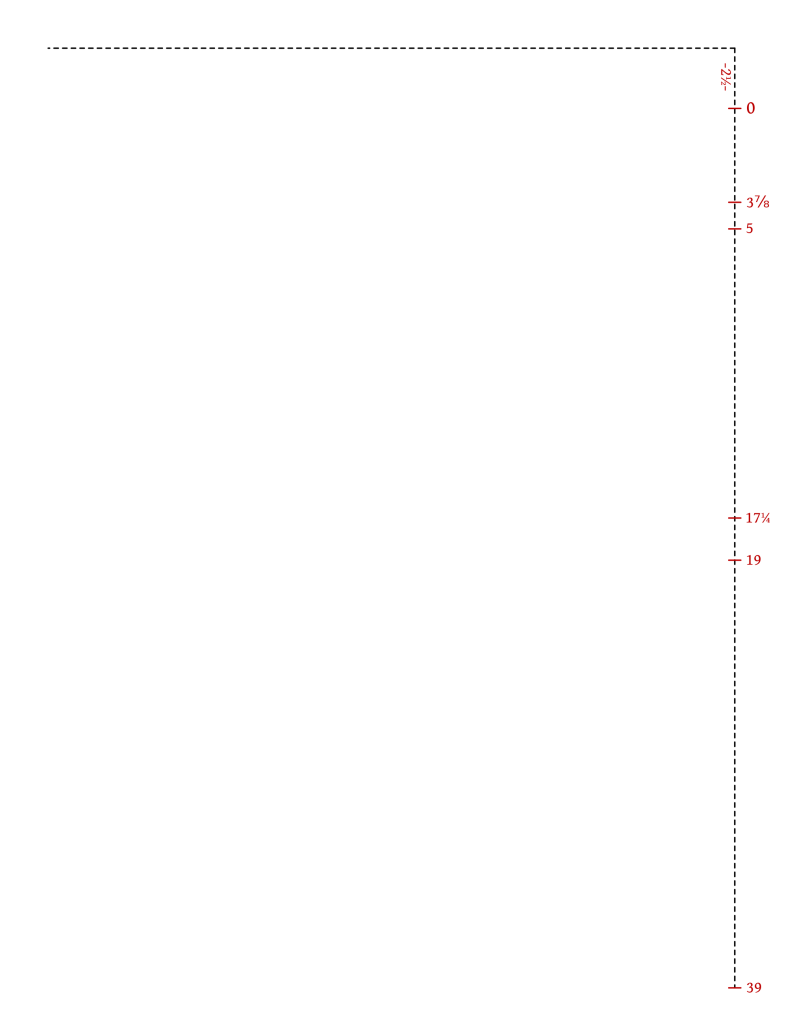
Now we’ll square lines across from each of those points and mark the following distances.
- 2 3/8 graduated inches from 0. Then square up 1/2 graduated inches as shown for the back shoulder/neck point.
- 7 1/2 graduated inches from 3 7/8 for the width of back.
- 7 1/2 graduated inches from 5 for the bottom of the armscye. This line also forms the front armscye so you can extend it further as shown.
- 1 1/2 and 3 7/8 graduated inches from 17 1/4 for the back width of the waist.
- 1 1/2 graduated inches from 19.
- Square across from 39 for the bottom of your draft.
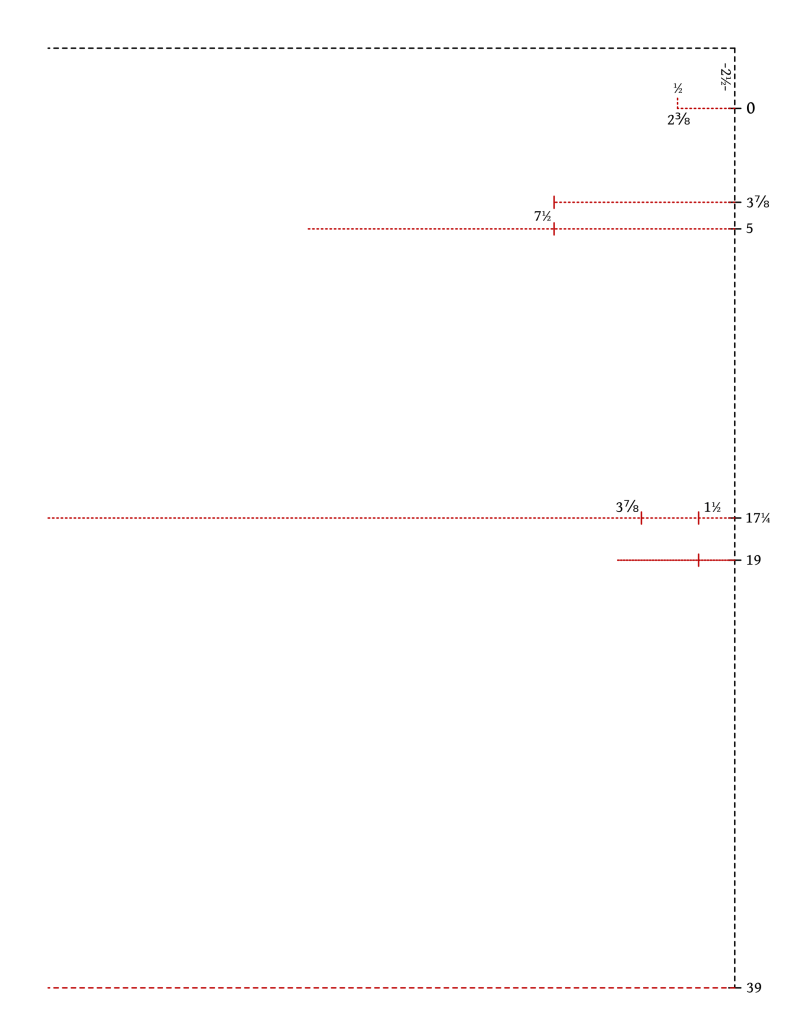
Now we’ll add some construction lines to make drawing the curves a little easier.
- Draw a line from 0 to 1 1/2, extending it straight down to the line at 19. This forms the center back with a slight amount of ‘spring’ below the waist.
- Draw a line parallel to the line from 0 – 1 1/2, from 3 7/8. This is more of a guide for forming the back curve but does form the other side of the back at the waist.
- Back near the top, draw a line from the 1/2 mark to the top 7 1/2 mark for the shoulder curve.
- From the lower 7 1/2 to 1 1/2, draw a line to aid in drawing the back curve.
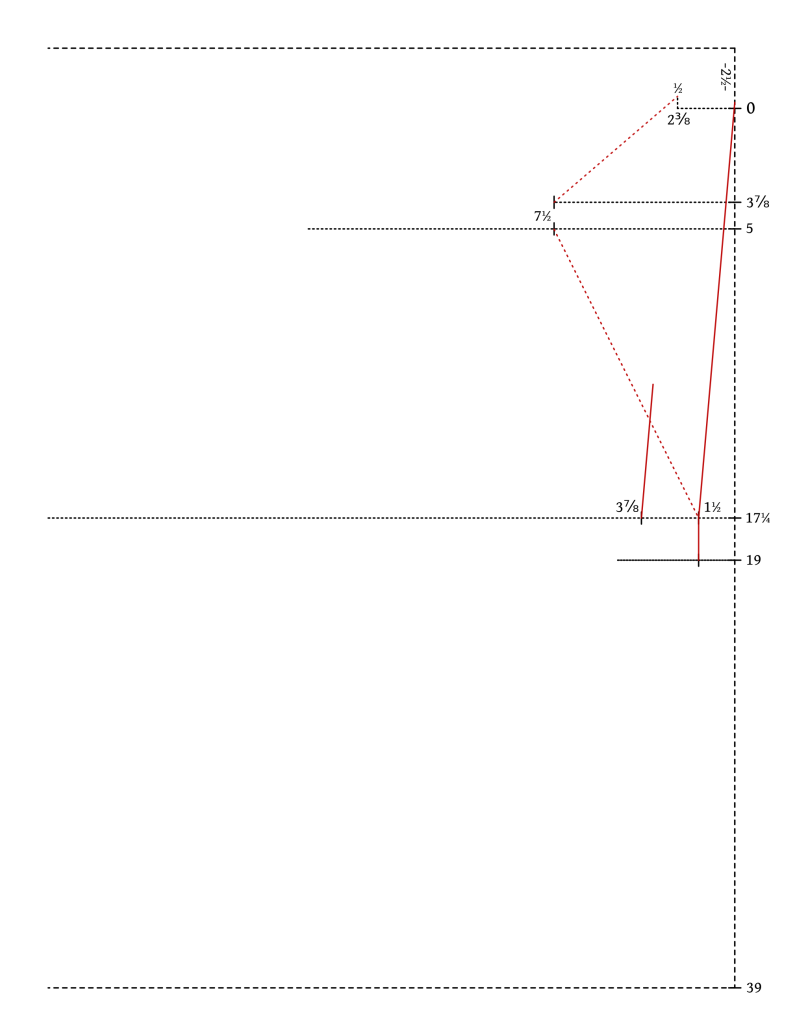
These next two small lines give the depths of each curve.
- Find the center of the shoulder seam and square a line inwards 3/8 of a graduated inch.
- On the line from 7 1/2 – 1 1/2, measure 4 graduated inches from 7 1/2 and square inward 3/4 of a graduated inch.
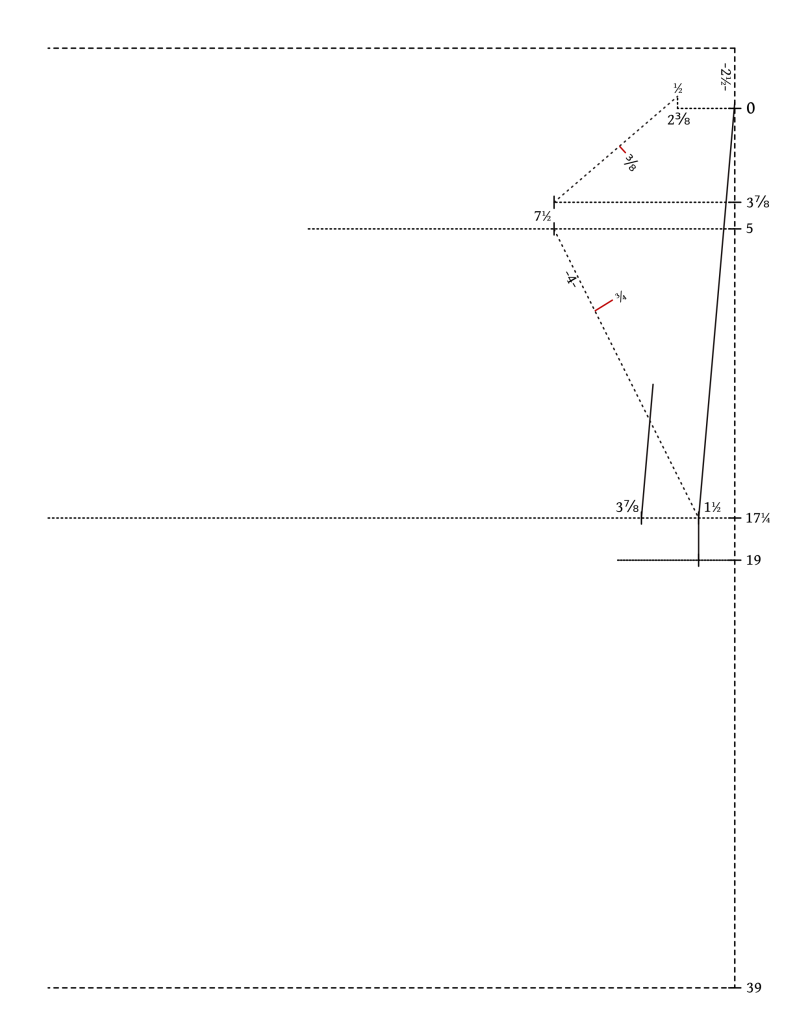
With the construction lines drawn, we can add in the curves now.
- From 1/2 – 0 draw a curve for the back neck.
- Draw a curve from 7 1/2 through 3/8 to 1/2 for the shoulder seam.
- From 7 1/2 to 7 1/2 draw a very slight curve for the back of the armscye.
- From the lower 7 1/2 through 3/4 to through 3 7/8, draw a curve, straightening the curve as it hits the construction line and continuing straight to line 19.
- Finally, add a very shallow curve at 1 1/2 near the waist just to soften the angle a little.
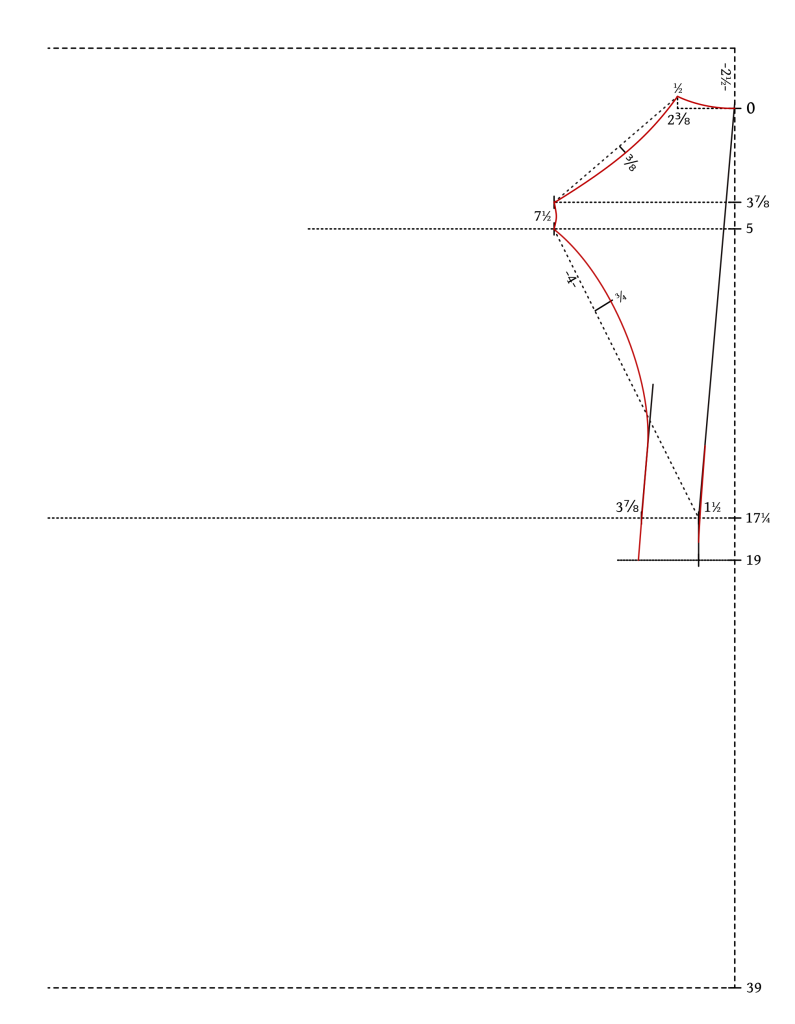
Finally, we’ll finish up the back piece with the skirt area.
- At the top of the skirt near 19, ‘spring out’ the top about 1/8 of a graduated inch at 19.
- From 19 to 39, give a very slight curve, deeper near the top half, to the center back of the skirt. When the back skirt is made up, it will give the appearance of being a straight line, ideally, as it goes over the curve of the seat.
- Again at line 19 at the side seam area, mark a line at line 19, 7/8 of a graduated inch past the construction line coming from 3 7/8. Also spring up here 3/8 of a graduated inch.
- Measure the width of the skirt at line 19. Add 3/4 of a graduated inch to the bottom width of the skirt at 39.
- Redraw the side of the skirt from 3/8 to 3/4 as shown.
- Finally, draw a slight curve to the bottom, ensuring that the angle at 3/4 is at 90 degrees, as well as at 39.
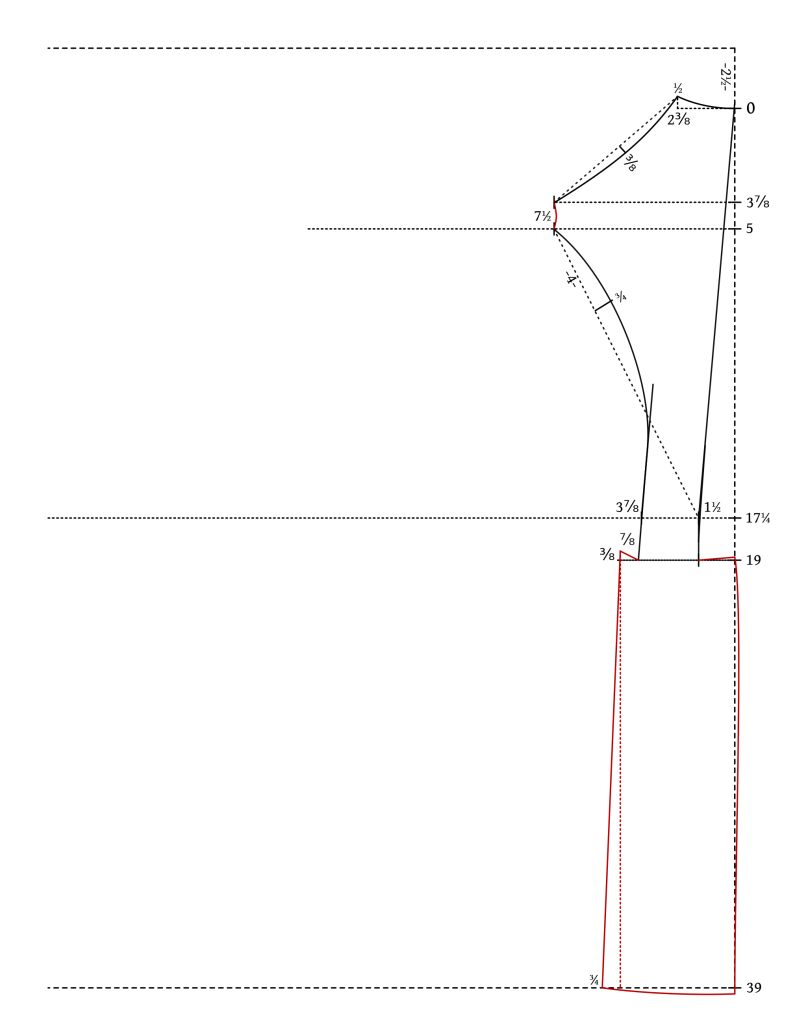
Supplies
Here’s the list of supplies you’ll need for this project.
- Pattern / Poster Paper (available in craft stores or some office supply stores).
- Quilting Ruler
- Tape Measure
- Pencil
- French Curves or bendable Drafting Ruler (both are optional)
- 1 – 2 yards Cotton Muslin and Thread for sewing
Graduated Rulers
To make your pattern the appropriate size, you’ll need to print out the ruler corresponding to your chest size. The rulers can be found on the main page of this course.
Fitting and Alterations
A waistcoat, with only a few seams, is one of the easiest garments to fit. After you have constructed your toile, try it on, and look for any excess fabric, or pulling. This will help you decide on the adjustments to be made on the pattern.
At the waist, is the waistcoat loose or tight? Try to determine by how much, either by measuring or rock of eye (estimating). Any alterations at the waist can be added at the back side seam and the center front. Since waistcoats from the 1860s almost always had a belt in the back for adjustment, I usually make the side seam in the back vertical, just to give some extra room to grow into.
Then examine the back neck for the balance. Once you’ve learned this you’ll be staring at the back of other people’s coats to see how their balance is. If the balance is too long, you’ll see horizontal folds just under the collar or neck area. And if the balance is too short the back of the vest will pull way from the neck – you see this often if someone has a stooped posture.

As everybody is different, it’d be impossible for me to go over every possible variation. So, if you’d like help with your fitting, please share in the support community a photo of your pattern from the top down, as well as photos of you wearing the waistcoat from the front, sides, and back, and I’ll help you with the alterations as best I can.
Muslin Toile
With the pattern cut out you can cut out your cotton muslin to make a toile for fitting purposes. Please refer to the video for more detailed construction.
First, cut out your fabric with the center back placed on the fold, following the grain alignment marks for both front and back. Any darts are simply marked but are not cut out. Mark an ‘X’ on the wrong side of each piece to help keep everything in order.
Next, if you’re using any darts, it’s time to close them up while the pieces are still separate and easier to deal with. Fold the dart in half lengthwise, right sides together, aligning the chalk marks on both sides as best you can.
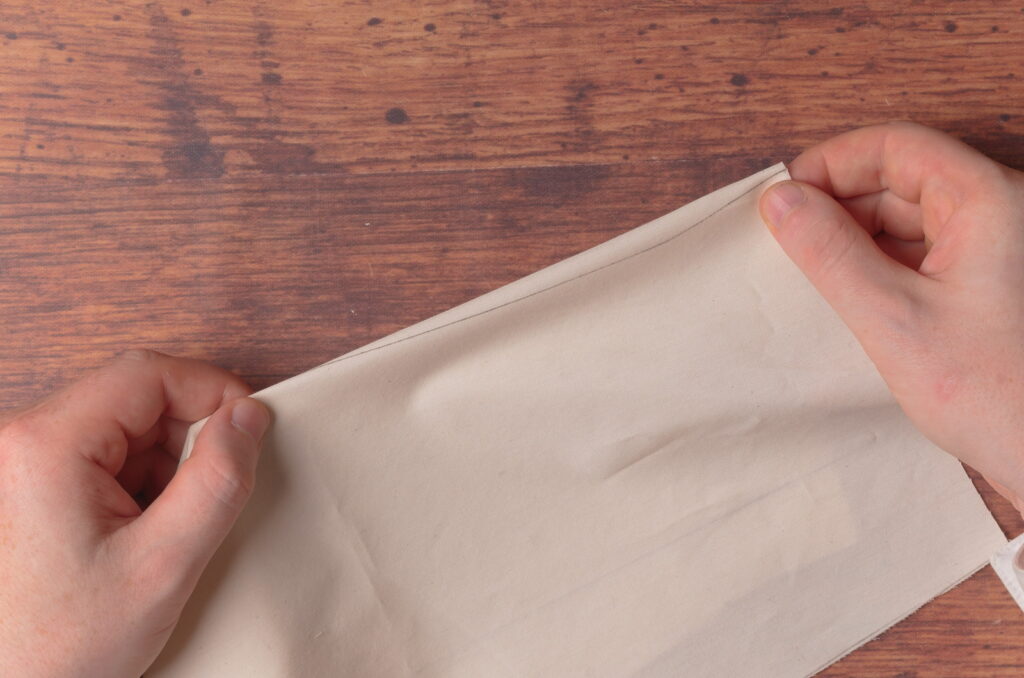
Pin the dart closed.
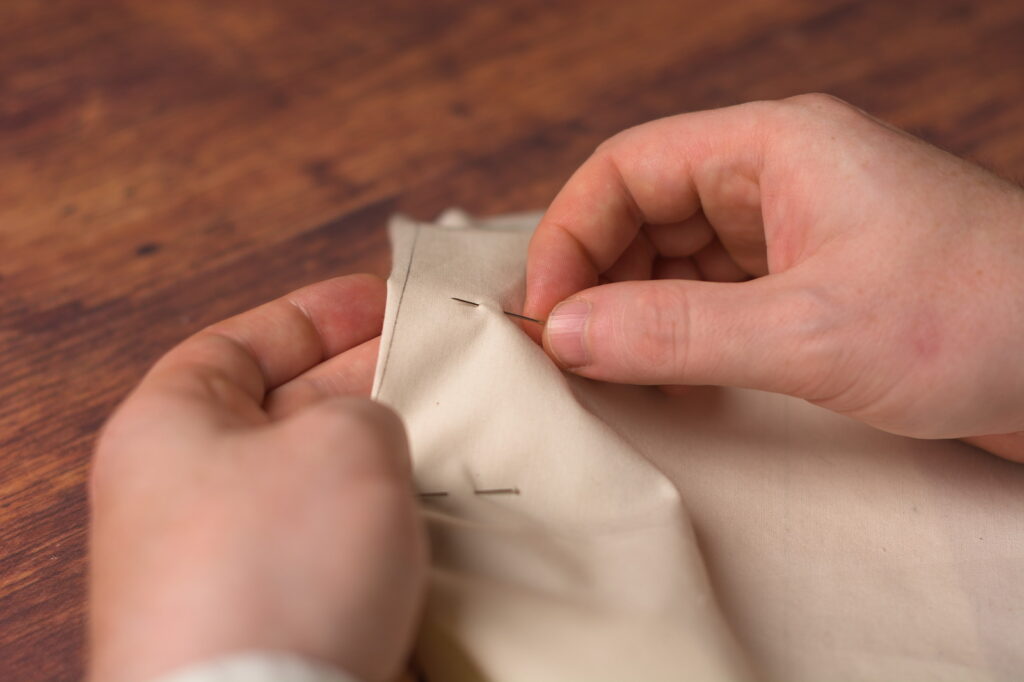
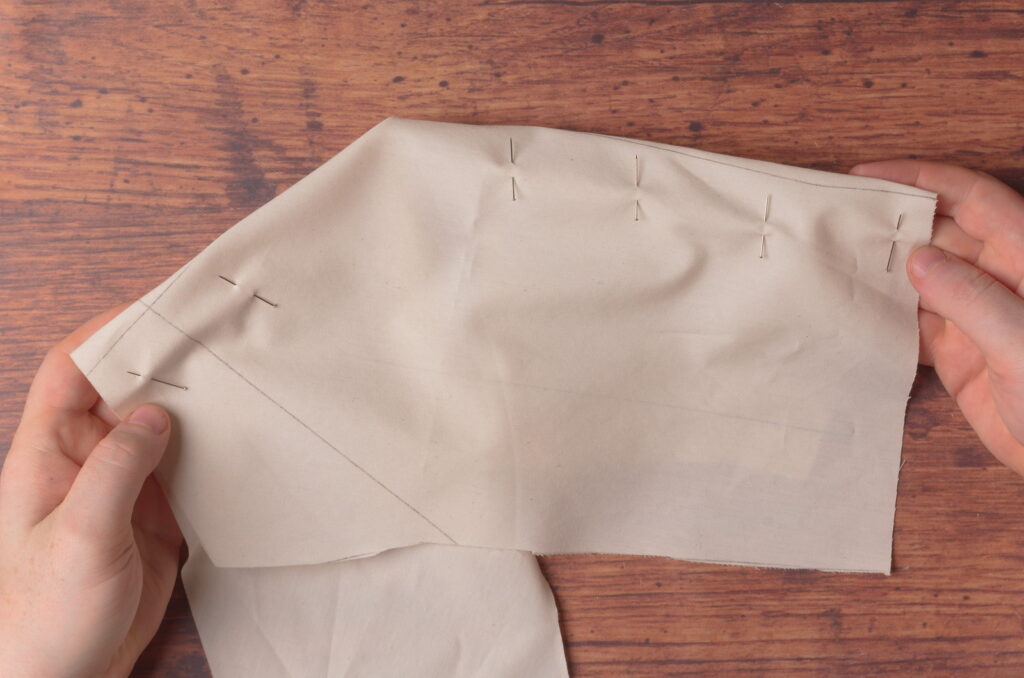
Sew the dart closed from the bottom of the dart towards the tip, opposite of what I did in the photo, for best results. Follow the outside of the chalk line as closely as you can.
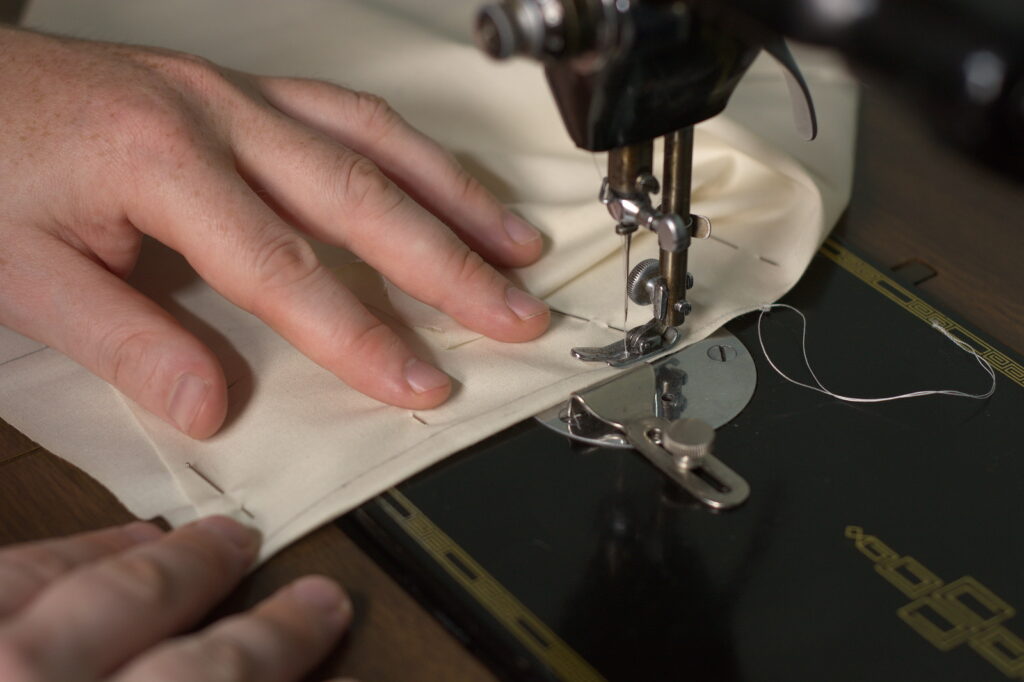
Press the dart to one side.
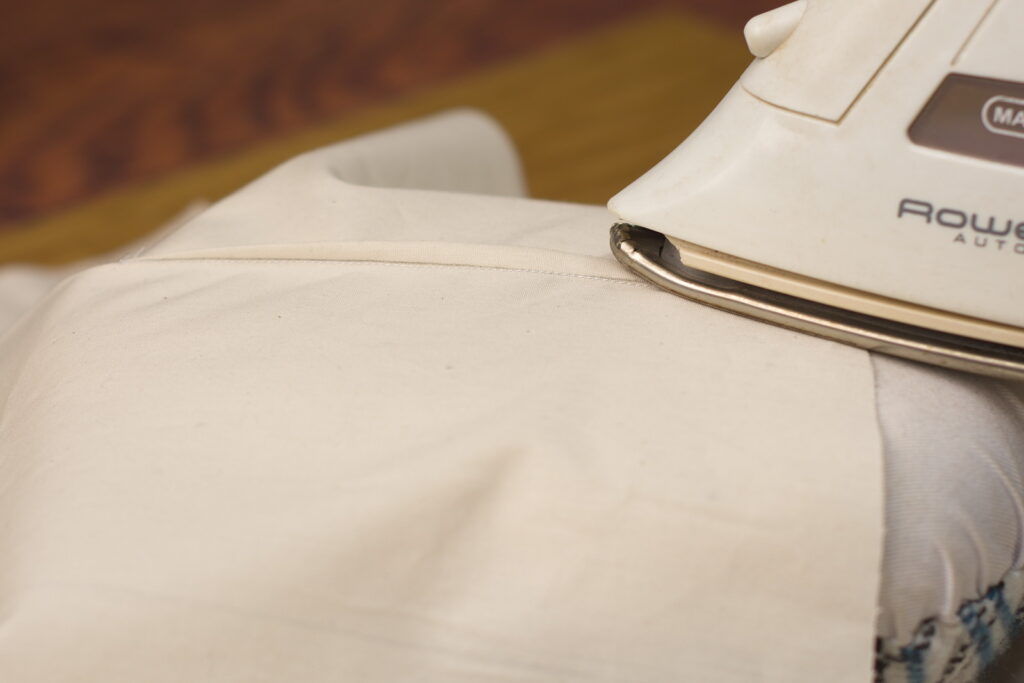
Pin the side seams together.

Also pin the shoulder seams, aligning the seam allowances carefully.
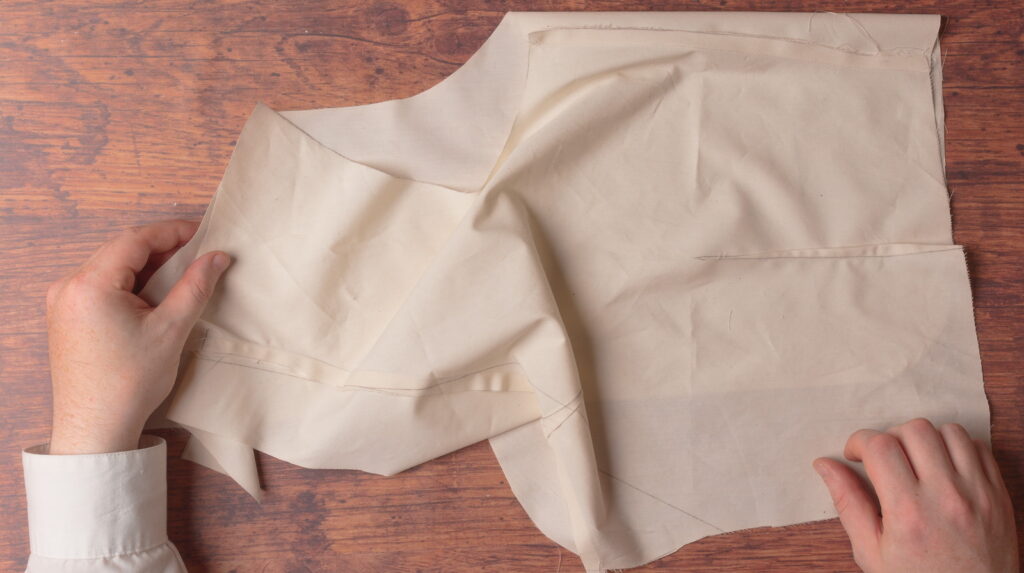
At both ends of the shoulder seam you’ll end up with a little overlap due to the angles of the neck and armscye. Just keep the 3/8″ seam allowance aligned.

Sew the shoulder seams and side seams closed with a 3/8″ seam allowance.
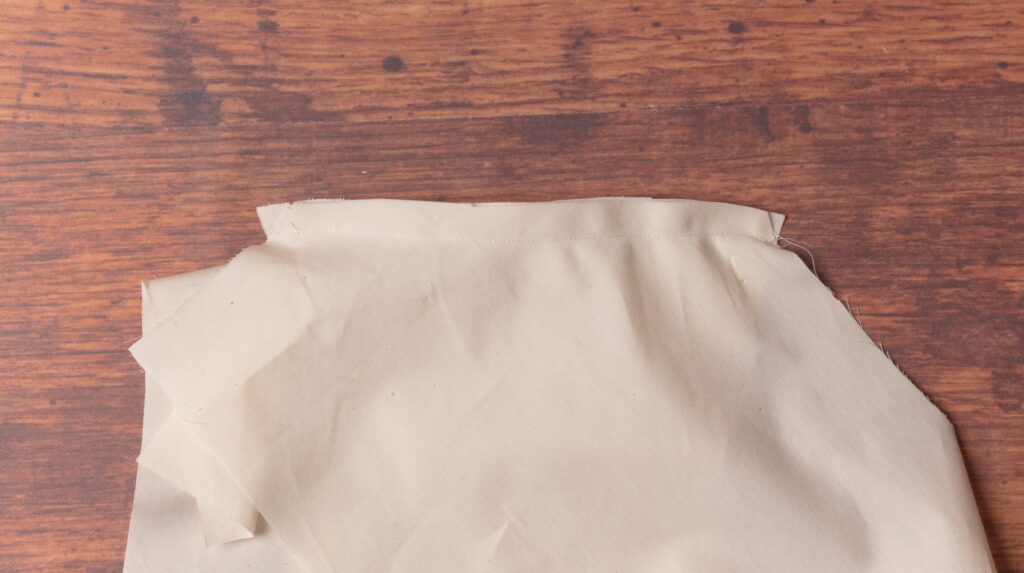
Press open the shoulder and side seams. It’s helpful to use a tailor’s ham for the curve of the shoulder seam if you have one.
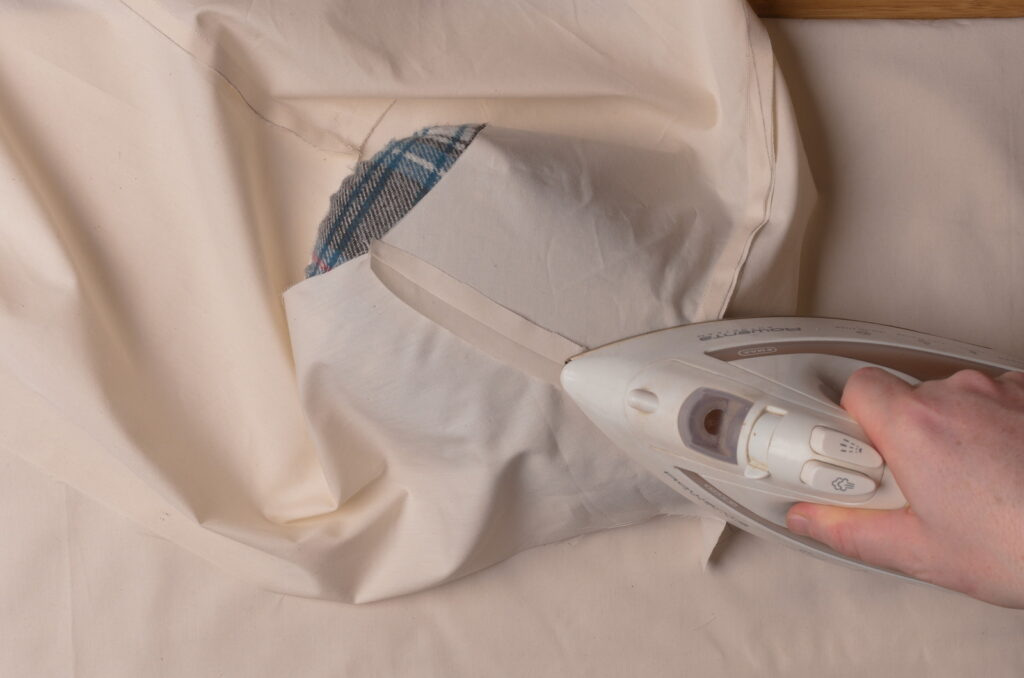
And that completes your waistcoat toile. Go try it on to see how it fits!
Checking your Measurements
Before cutting out your pattern (or after if you forget!), it’s a good idea to check your measurements one last time. Here I’ve got them all laid out for you in one diagram. Remember that you want to measure without including the seam allowances. Also, keep in mind that any pattern is just a start – it takes fitting to perfect the pattern, especially if you are a beginner, and don’t be afraid to start completely from scratch if necessary. The next pattern will be all the better. When you’re comfortable enough with your draft, you can go ahead and cut it out – be sure to keep the seam allowances!
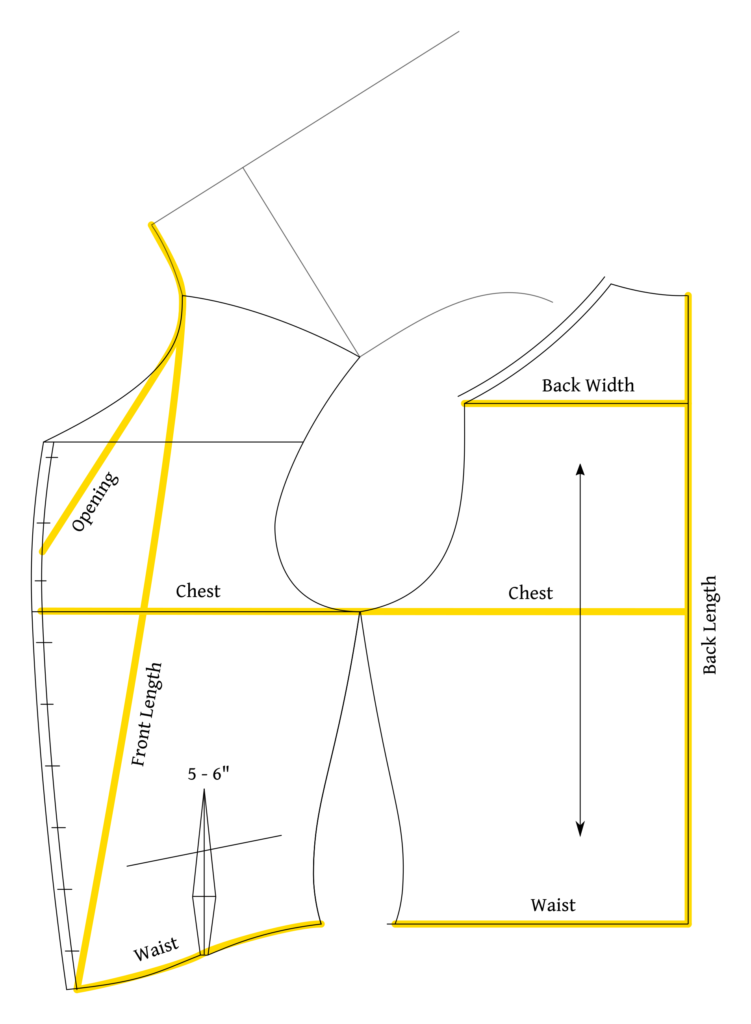
Darts
If you have a very athletic build, you may be able to add a dart to the front for additional waist suppression and more shape. These darts should only be added if your waist measurement is at least 6″ smaller than your chest measurement.
First, determine the position and length of your dart, usually at the middle of the front waist, and extending through the pocket vertically, about 5 – 6″ in length.
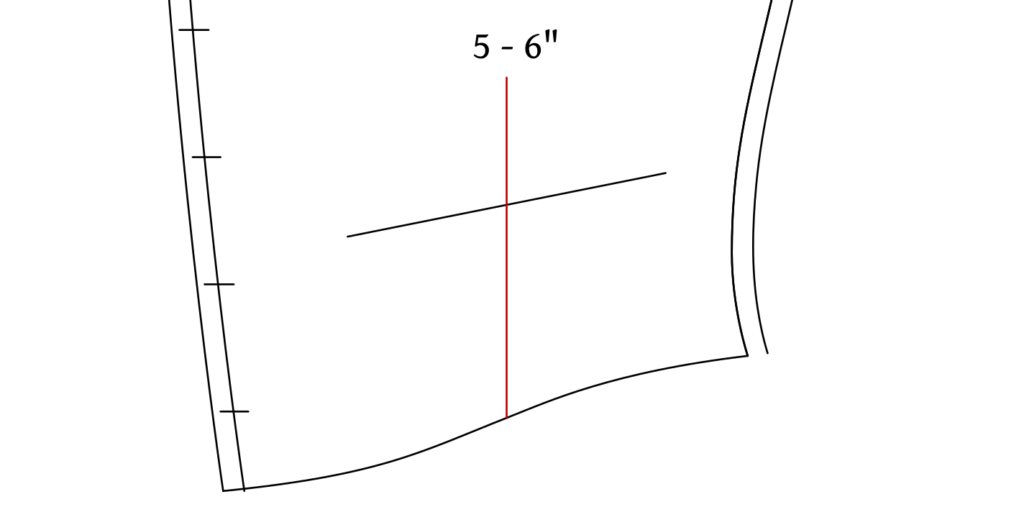
Next, about two inches from the bottom, or where the natural waist would be, determine the width of your dart. This is best done by checking the length of the waist across the two pieces, comparing it to your actual waist measurement, and taking out from between 1/2″ to 1″ total at this position in the dart. You’ll have to use your best judgement as to how much to take out in the darts, as compared to the side seams, but feel free to ask me for advice here.
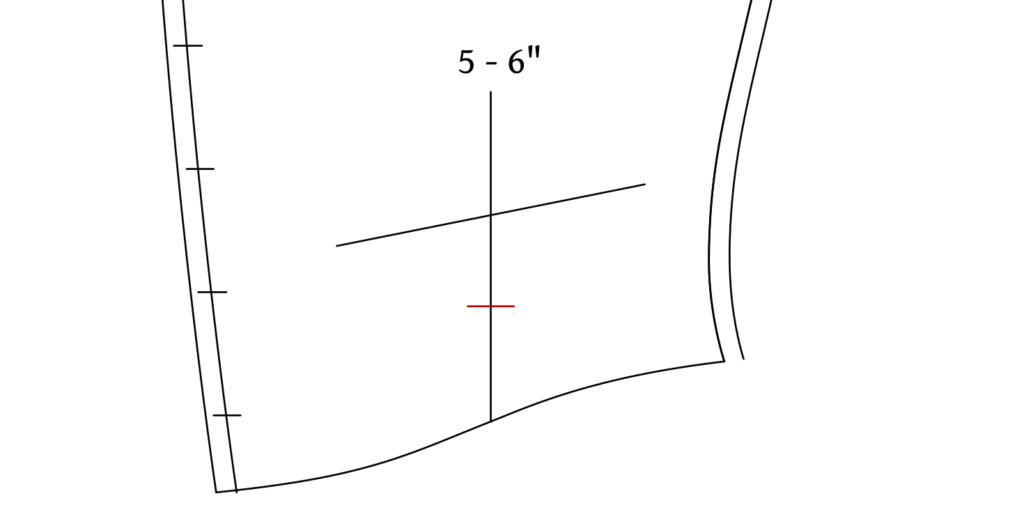
Now connect the points of the dart. I usually make the bottom about 1/4″ wide, or 1/8″ on either side of the construction line, but again that depends on how wide you’ve made the fullest part of the dart.
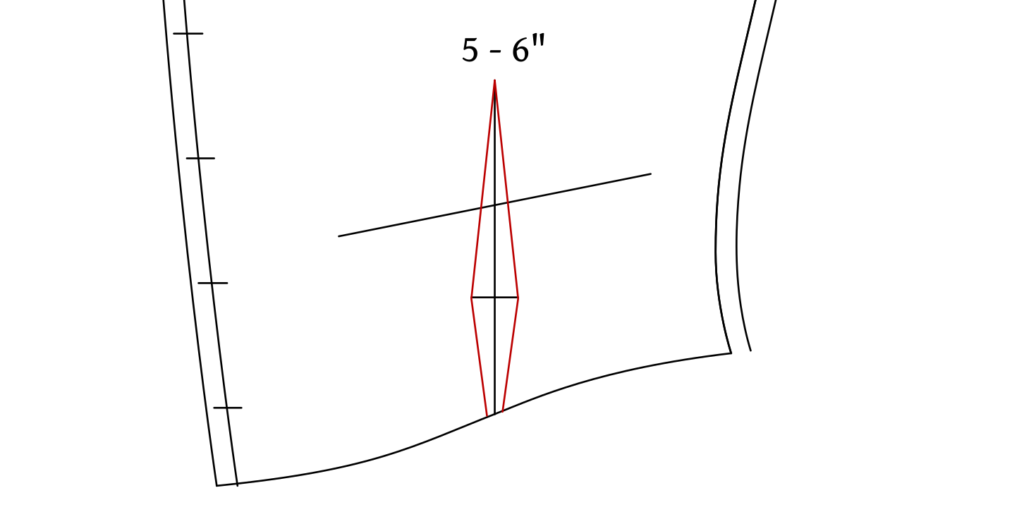
Finally, I like to lower the waist seam at the back edge of the darts, just to make the lengths equal. It helps a bit when making up the waistcoat, otherwise you end up with a jagged looking bottom edge before turning, and can run out of seam allowance if you’re not using an inlay.
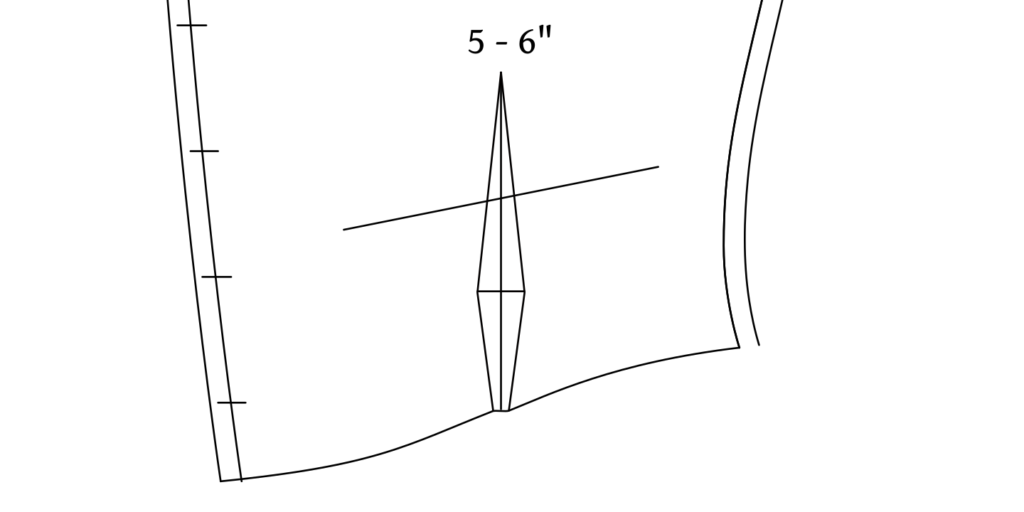
Adding Seam Allowances
With your draft done, you’ll need to add a few seam allowances to make sure it fits properly. Since this is only going to be a muslin toile for fitting purposes, I typically add seam allowances only at the shoulders and side seams. I’d recommend 3/8″ (actual inches) here, as it gives more room to work with than 1/4″ as well as prevents fraying, while at the same time not being quite as bulky as a full 1/2″.
Now, you do have a choice to make here. You could add the seam allowances directly to your pattern and cut everything out afterwards – this does break apart your original pattern however. Or you can copy the outlines and waist / chest lines to a fresh sheet of paper and add the seam allowances to that so as to preserve your original pattern for future use. It’s up to you and one way isn’t really more difficult than the other – it’s more how you prefer to work.
Use your quilting ruler to add the seam allowances to the shoulder seams and side seams.
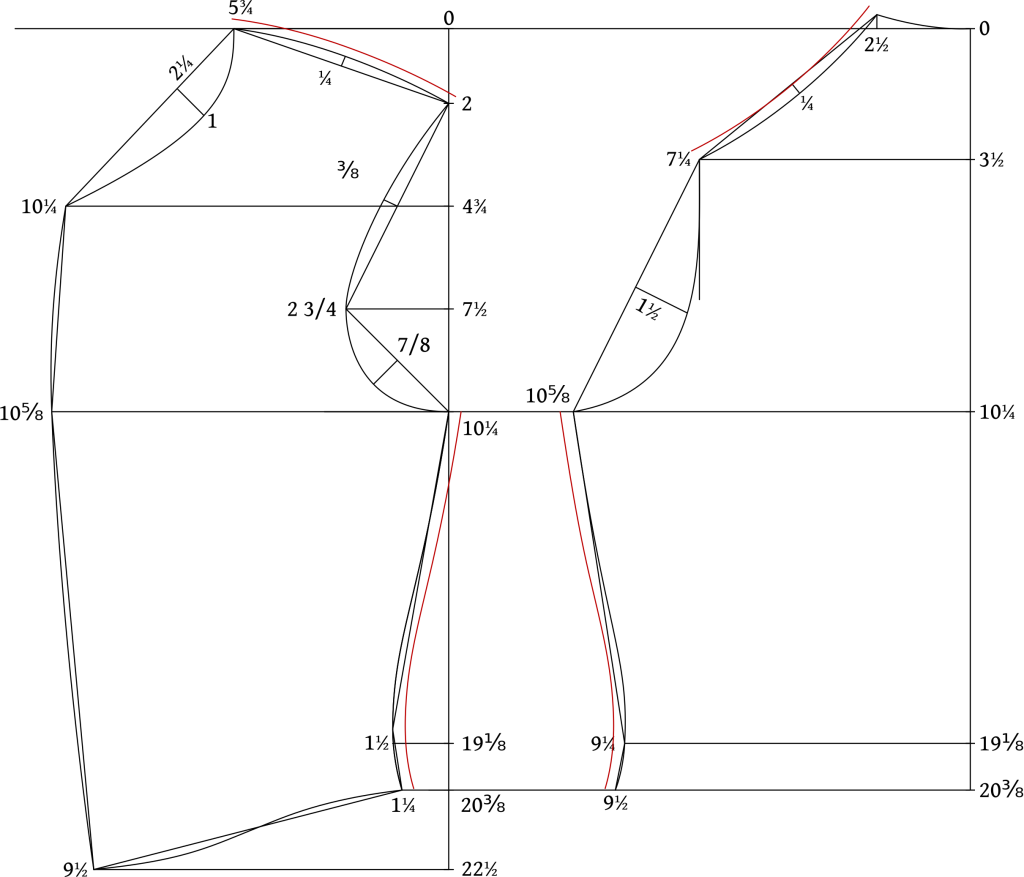
Here’s a simplified view of the pattern so far after adding seam allowances at the shoulders and side seams. I’ve also added some vertical lines to indicate the grain of the cloth – just makes it easier to keep track of when cutting everything out.
Along the front edge I added the position of the buttons. These are 3/8″ (graduated or not) inches from the edge. The top button is about 1/2″ from the top, the lowest button is about an inch from the bottom. Then I just spaced the buttons evenly from top to bottom for a total of nine.
Finally, although it’s out of the scope of this course, I added a pocket along the bottom of the front just for reference. It’s about 5 graduated inches long, and roughly follows the waist construction line about 3 – 4″ above that.
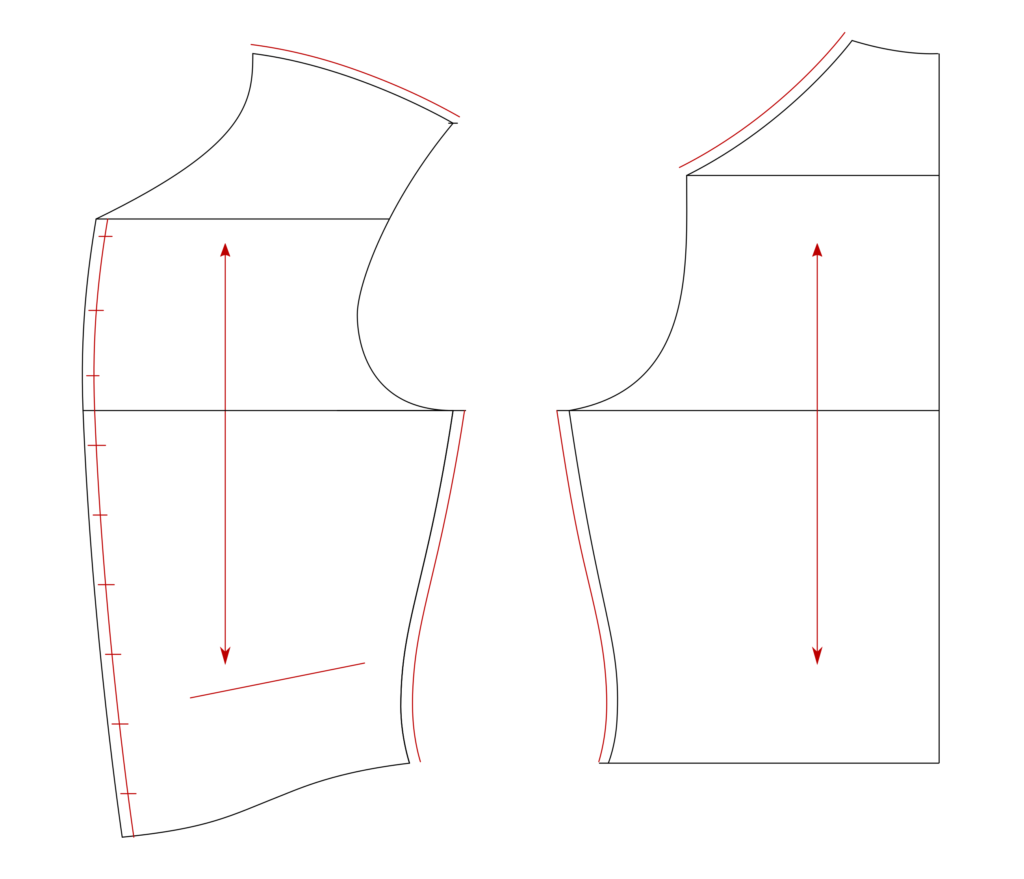
Drafting the Front
With the back completed, we can move on to drafting the front of the waistcoat, or forepart.
Begin by drawing another vertical line about 2 – 3 inches away from the back piece – just to give yourself room to work with. Mark the following points from 0 in graduated inches.
- Mark 0 at the top.
- 2
- 4 3/4
- 7 1/2
- 10 1/4
- 19 1/8
- 20 3/8
- 22 1/2
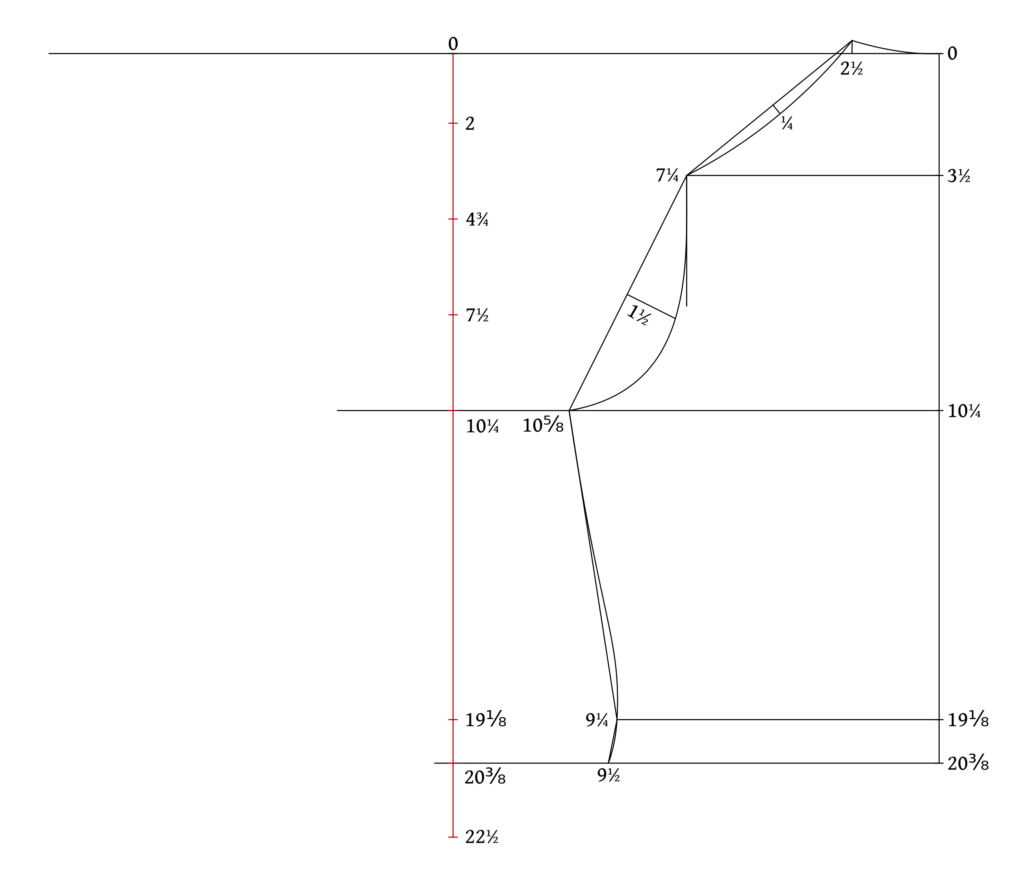
Square across from these points as before – some of the lines you may have already drawn if you extended them far enough from the back. Then measure out the following distances.
- 5 3/4 from 0
- 10 1/4 from 4 3/4
- 2 3/4 from 7 1/2
- 10 5/8 from 10 1/4
- 1 1/2 from 19 1/8
- 1 1/4 from 20 3/8
- 9 1/2 from 22 1/2
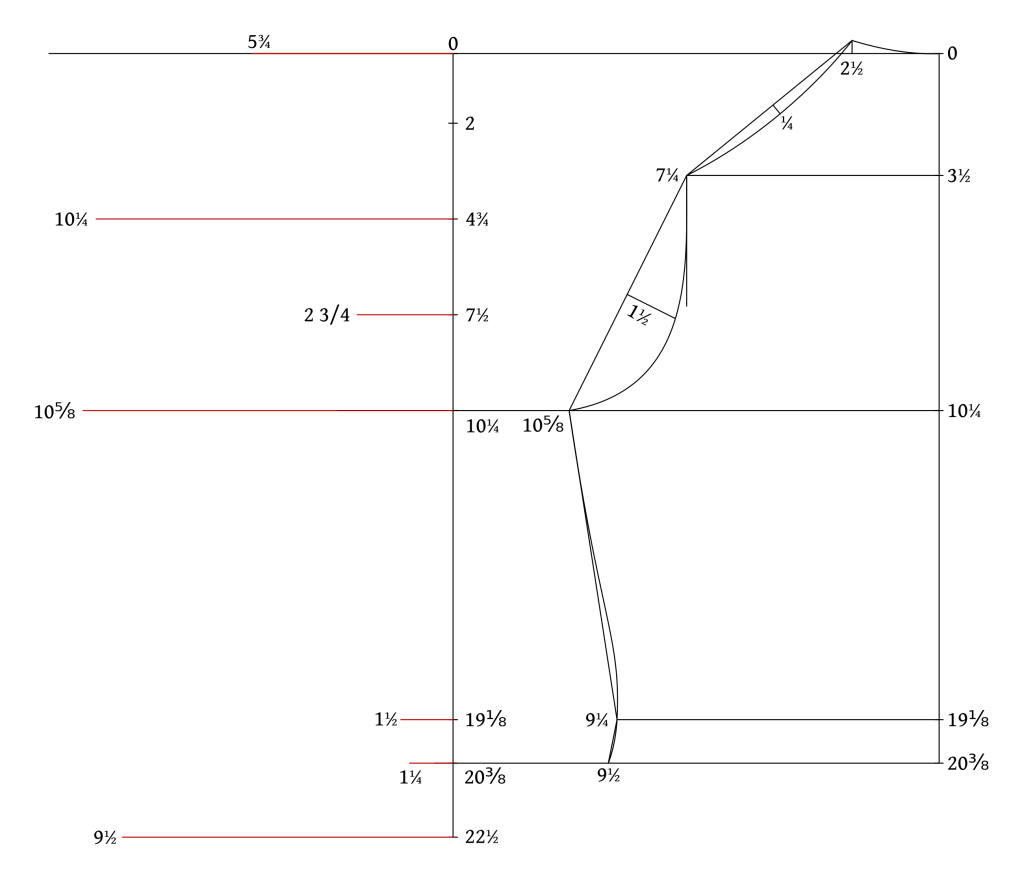
Draw in the construction lines connecting the following points to aid in drawing the curves.
- 5 3/4 to 2 for the shoulder.
- 2 to 2 3/4 for the front armscye.
- 2 3/4 to 10 1/4 for the bottom armscye.
- 10 1/4 through 1 1/2 to 1 1/4 for the side seam.
- 1 1/4 to 9 1/2 for the waist seam.
- 9 1/2 through 10 5/8 to 10 1/4 for the center front.
- 10 1/4 to 5 3/4 for the neck seam.
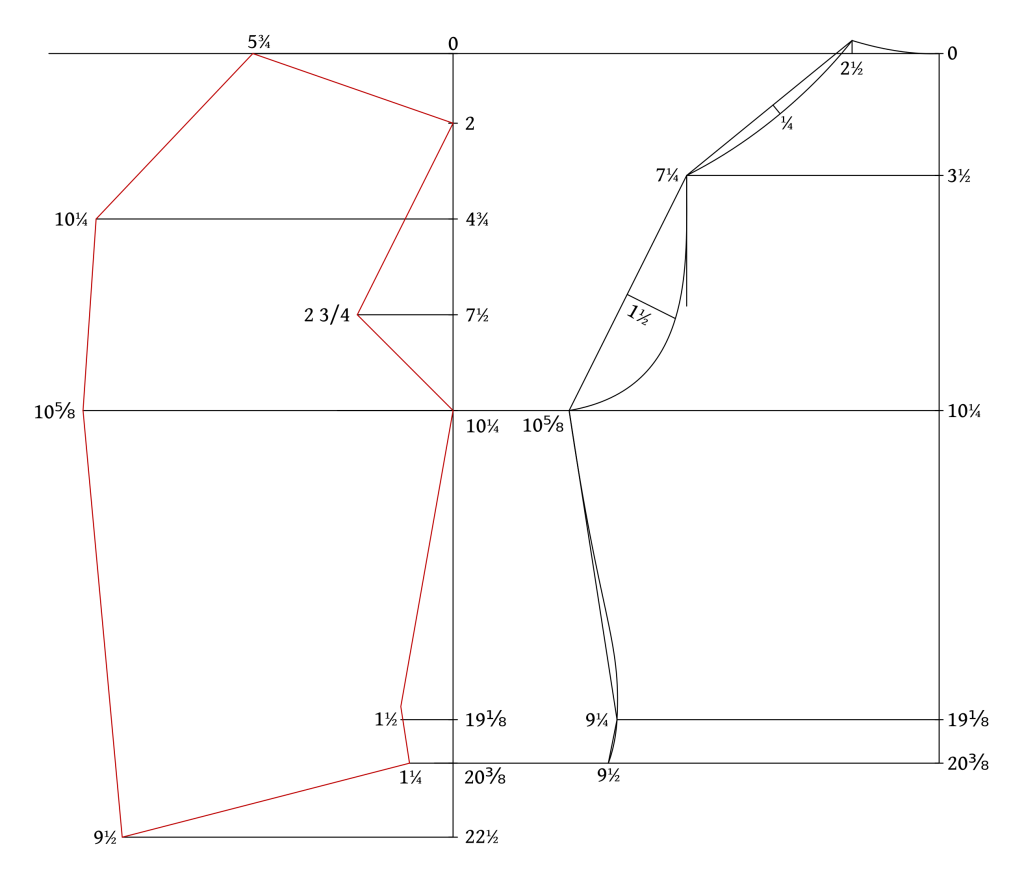
To find the depth of the curves:
- Measure 2 1/4 graduated inches from 5 3/4 along the neckline. Square in 1 inch for the curve of the neck.
- Find the center of 5 3/4 to 2. Square out 1/4 graduated inch.
- Find the center of 2 to 2 3/4. Square in 3/8 graduated inch.
- Find the center of 2 3/4 to 10 1/4. Square in 7/8 graduated inch.
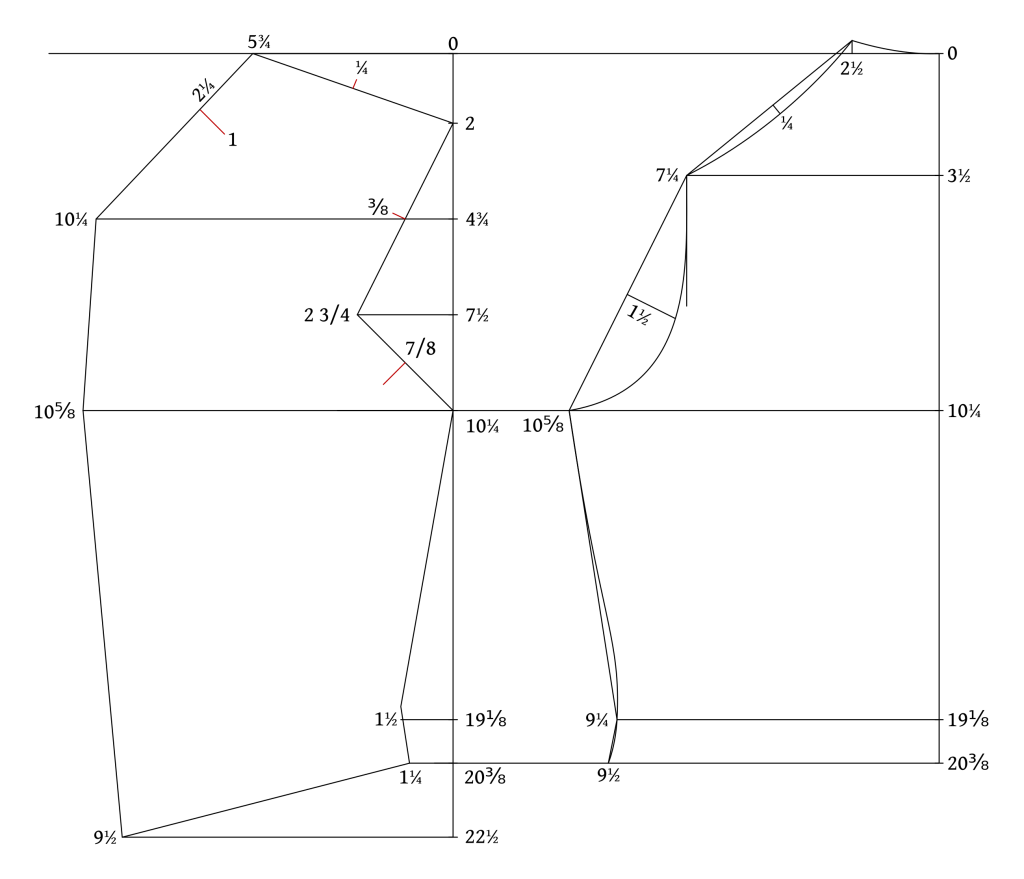
Finally, draw in the curves as shown:
- 5 3/4 to 2 forms the shoulder seam. Should be a shallow curve.
- 2 through 2 3/4 to 10 1/4 for the armscye. At 2 3/4, the curve should be close to vertical – that will help you with the shape of the curve.
- 10 1/4 through 1 1/2 to 1 1/4 for the side seam. This forms an ‘S’ curve very similar to the side seam of the back, just in the opposite direction.
- 9 1/2 to 1 1/4 for the waist seam. I like to first find the midpoint between the two. Then draw in a very shallow ‘S’ curve as shown. It should almost form a right angle with the center front.
- 9 1/2 through 10 5/8 to 10 1/4 for the center front.
- 10 1/4 through 1 to 5 3/4 for the neck seam. The curve starts out very shallow at 10 1/4 and deepens after 1. The curve should be just about vertical as it heads into 5 3/4.
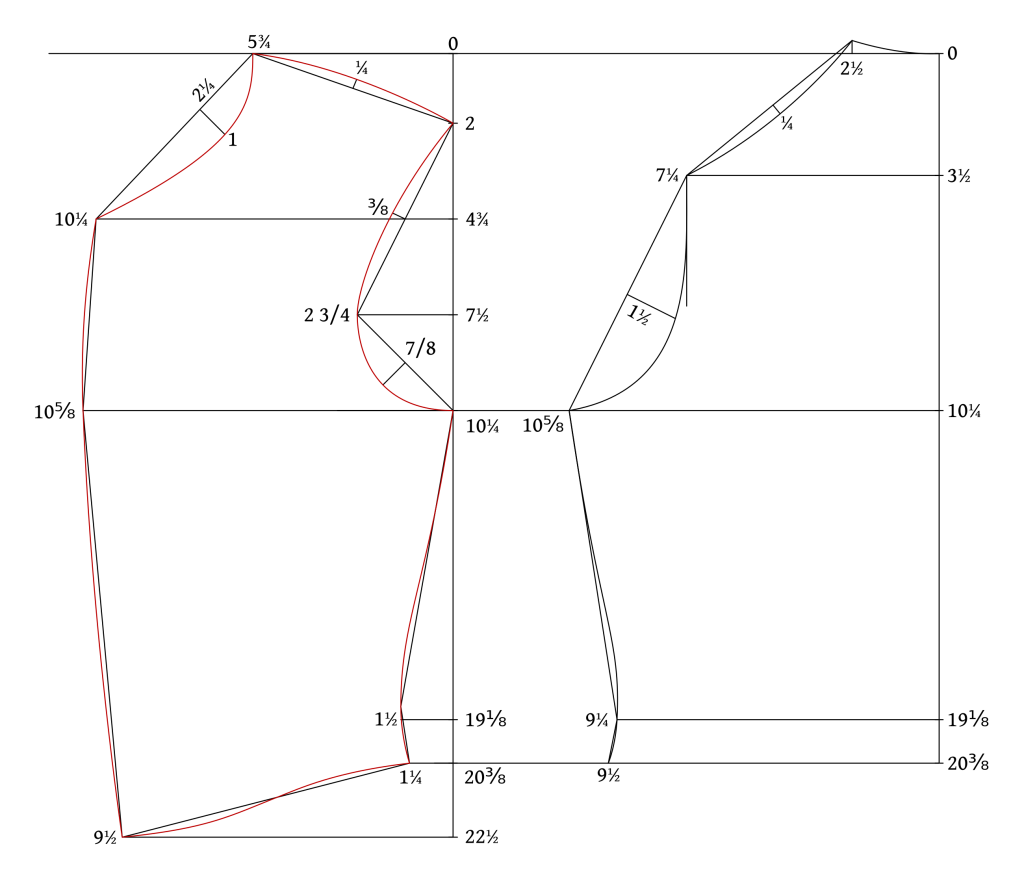
This completes the draft itself. Next we’ll add seam allowances and double check the measurements one last time.